There are so many amazing and yet overwhelming things about being a teacher that it can be a very fine line between your perception of the career toppling one way or the other. But after what has been a challenging term for I think all teachers, I want to properly think about what it is that makes this job worth (most of the time!) all the daily stress, hard-work and exhaustion.
The hilarious comments the kids come out with
I have a massive jar at school and a notes on my phone full of the random, hilarious and downright odd things kids have said, written or drawn in the last year alone. Yes, sometimes they can be a little bit mean like “I’m taking German next year because I hate you and you don’t teach German!” or a bit creepy such as “Miss can I compliment your tiny ears” (ew) but the best medicine after a rubbish day is to sit with your colleagues and open them all up for a good laugh! I do sometimes bring them up at parents evening or in calls/emails home too sometimes so the parents can have a laugh too – like my little year 7 boy last week who described his mum as “kind” and “generous” but then drew a picture of her with horns!
Getting to share positive news with parents and carers
At the end of every week (or sometimes the day if it’s been a particularly arduous one!) I absolutely love sending little emails or making quick phone calls home to let them know how hard their child has worked. We don’t always hear back from emails or voicemails but when we get a response saying something like “I’ll treat them to ice cream tonight!” or “I’ve printed this and stuck it on the fridge” or “He/she is reading it over my shoulder and is grinning from ear to ear” – it makes everything worth the stress. And just in case I don’t hear back (or worry that the message hasn’t got through) I usually stick a little sticker on the kids book, that way next lesson they ask “What’s this for?” and I get the opportunity to sneakily brag about how proud I am of them in front of the class!
I don’t even have kids of my own but it makes me so happy to know that the parents are getting to hear good things about their kid and have an excuse to treat them or spoil them just that little bit more over the weekend. At the end of the day when they’re all grown up they won’t remember the time they had a negative point for XY and Z but they will hopefully remember the time that an email from Miss from French convinced their mum into letting them have a sleepover or a takeaway.
Being trusted and confided in by the kids
As upsetting and as difficult as it is to have to watch as one of your class cries to you about something that’s happened or how they’re feeling, and knowing that there’s almost nothing you can do to comfort them – there is so much pride in knowing that they have made the best decision to come to an adult (maybe even you in particular) that they trust to help them solve the problem at hand.
I worry all the time that I’m only hearing the tip of the iceberg about what is going on but it is such a relief knowing that they have even trusted to tell me anything in the first place.
Hearing them talk about serious world issues in a sensitive way
My year 10s are particularly good at this, they frequently talk about LGBTQ+ rights, Black Lives Matter and British politics in a well-informed and respectful way. It is rarely me who starts these discussions and debates so knowing that these are topics they have willingly looked into themselves and are voluntarily discussing in such a mature way is probably the proudest I could ever be – it gives me such faith for their future and trust in them to make the right decisions and to be fair in life.
When your students successfully use a skill you spent months/years teaching them
I can (and do…daily!) repeat myself until I’m blue in the face and I’m usually under the impression that whatever I’m banging on about is going in one ear and straight out the other at breakneck speed. However, when I’m wandering around during a test or a particularly hard task and I overhear a little voice saying “well that’s a close-cognate so I can guess what that means” or I look over the shoulder during a writing and I see them “borrowing” phrases from another activity to use, it’s such a magical moment because you realise that your work here is done … well not quite but at least it’s one skill banked and evidence that they do actually listen sometimes.
Getting to teach content in fun and exciting ways
Not every lesson is fun and games but I know that it’s so so satisfying and exciting when I think of something out of the box, show the kids the new “game” and get to see their eyes light up when they see me rolling out a masking tap map onto the floor or dividing them into different fruit-themed groups for a game of Factile or hiding different cards around the room for a game of Cluedo or treasure hunt! When it runs smoothly and there aren’t any tantrums about losing, it’s so great to see them learning tonnes of new language and practicing new and advanced skills all while technically playing.
You learn something new everyday
It may be a new TikTok dance, the lyrics to a particularly rude song remix that you definitely didn’t have stuck in your head all day or simply just that you’ve been spelling “mademoiselle” wrong your whole life but there’s always something new and hopefully interesting to learn from your kids, their parents, your subject and your colleagues.
Seeing your students turn a bad day to a good day all by themselves
Parents and teachers alike spend years and years and years teaching their kids how to manage their emotions and how to be resilient and even in high school they (and the teachers!) don’t always get it right and might seek guidance from friends or heads of year. But when you see that, for whatever reason, their day hasn’t got off to the best of starts and you watch as they not only turn it around completely by themselves but they do it appropriately, maturely and in the way that they’ve been taught -it’s truly the best feeling.
Getting asked thoughtful and interesting questions
When kids ask questions that come from a place of curiosity and genuine interest in the subject it is such a nice feeling because they genuinely want to know and learn more about what you’re teaching. My favourite questions are the well thought out and well-worded ones that take me completely by surprise such as “Is the French word “regarder” linked to the English word “regard”?” and “Do people in French colonies hate the French language because it’s their oppressors language?”
Finally… there’s never a dull moment!
This is partly because there’s never a spare moment either but I don’t think I’d ever use the word “boring” to describe teaching. There’s always something unexpected going on that sweeps you off your feet and you just have to roll with it and pretend like you know what you’re doing!

















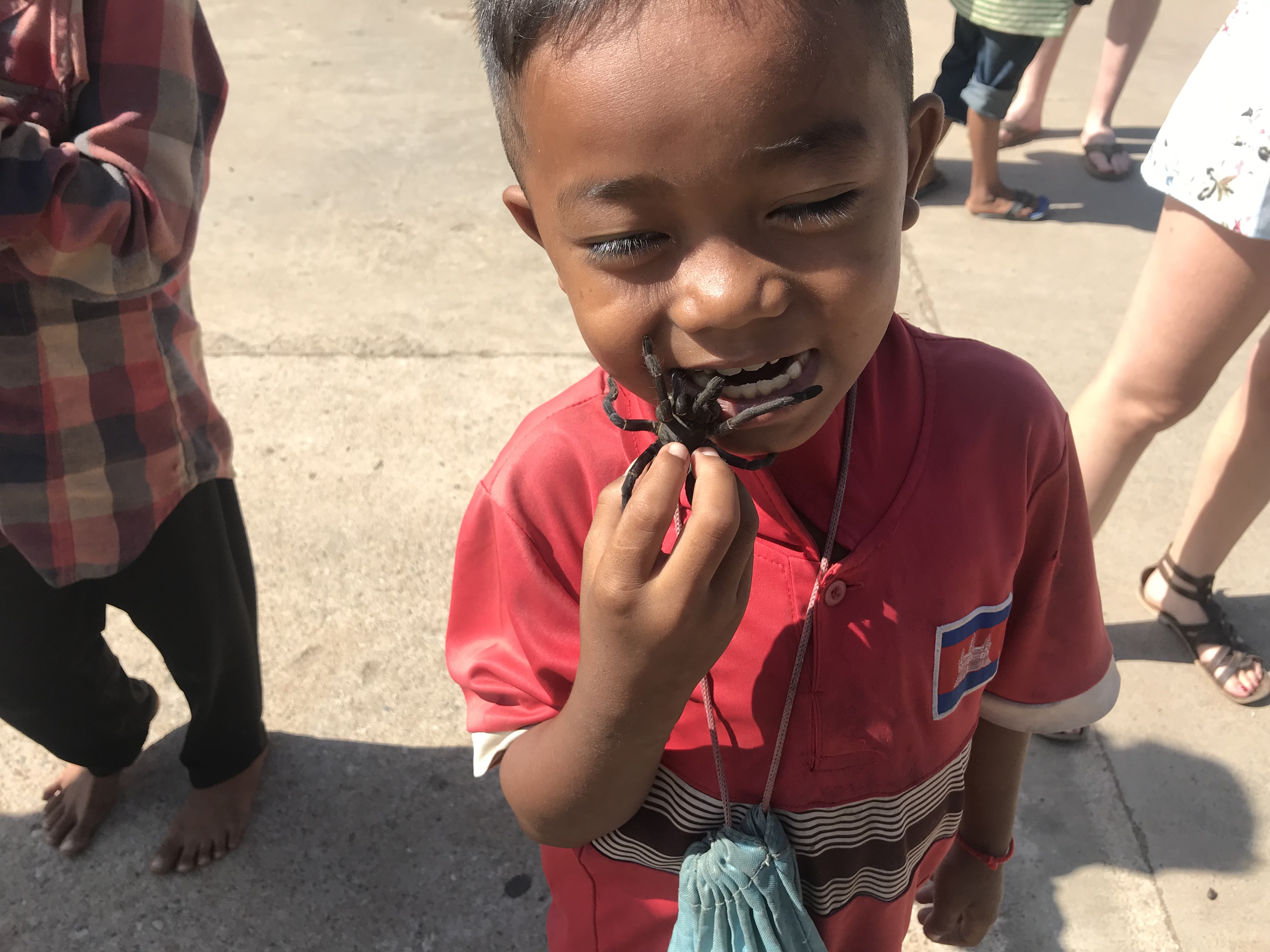 And before the doors had even fully opened three little kids carrying live tarantulas in their hands, hair and mouths had boarded the bus. The market is primarily for the trade of insects and other various meats and produce but is a common stop for tourist buses due to the unique culture of eating scorpions, tarantulas, ants and grubs. The kids of the vendors have, over the years, earnt themselves a name for taking great pleasure in winding up arachnophobic visitors and calmly posing for pictures with the insects chilling in their mouths or sprawled across their faces.
And before the doors had even fully opened three little kids carrying live tarantulas in their hands, hair and mouths had boarded the bus. The market is primarily for the trade of insects and other various meats and produce but is a common stop for tourist buses due to the unique culture of eating scorpions, tarantulas, ants and grubs. The kids of the vendors have, over the years, earnt themselves a name for taking great pleasure in winding up arachnophobic visitors and calmly posing for pictures with the insects chilling in their mouths or sprawled across their faces.

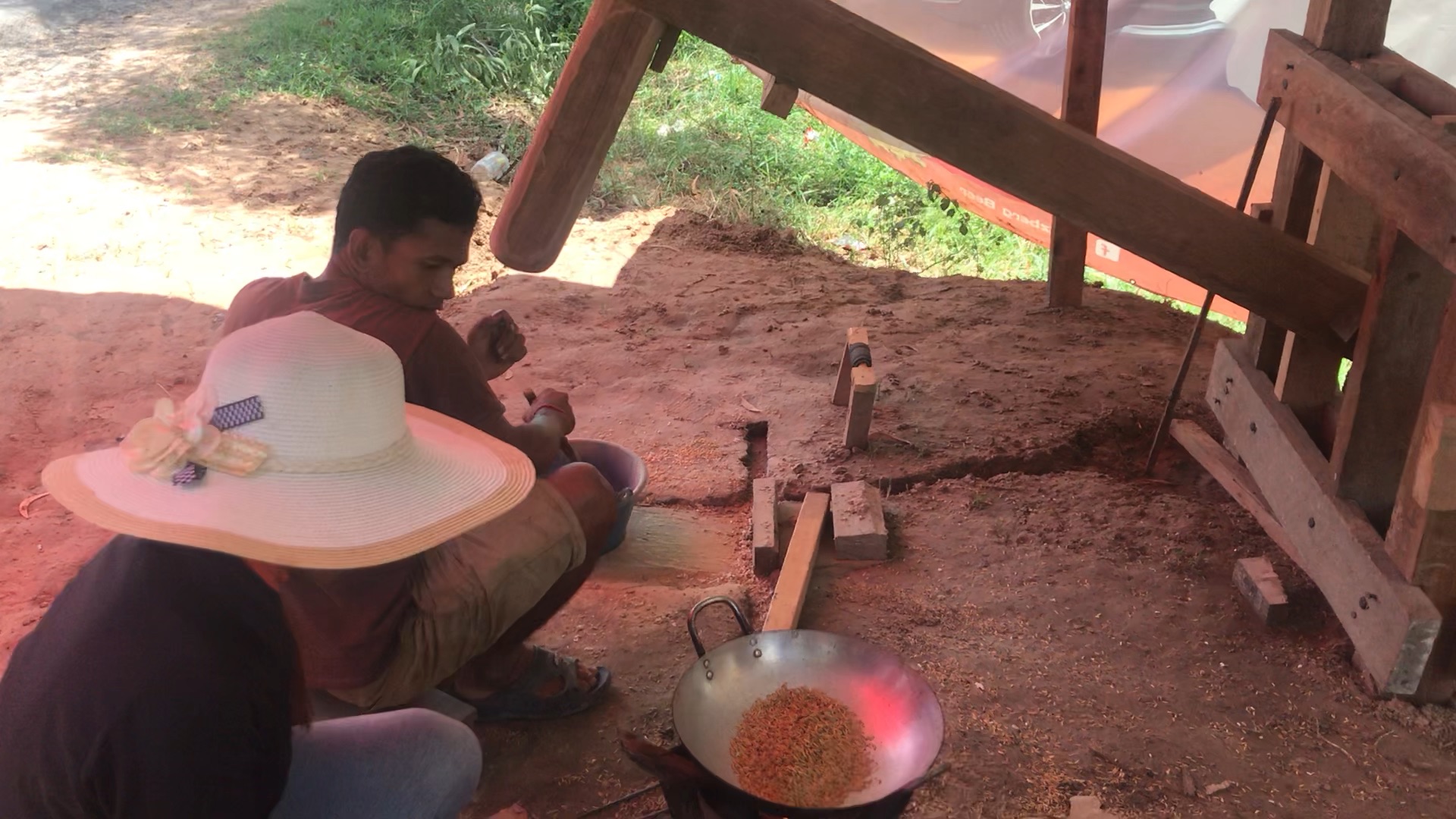 We also made a sudden and impromptu roadside stop in the Kampong Thom province where families were processing raw rice using traditional bodyweight machinery that resembled a one-person seesaw. It took about another 5 hours to get to Siem Reap from there and the closer you got, the bumpier and more pot-holey the roads became but what better way to get rid of a bit of travel sickness than with some off-road quad biking right?
We also made a sudden and impromptu roadside stop in the Kampong Thom province where families were processing raw rice using traditional bodyweight machinery that resembled a one-person seesaw. It took about another 5 hours to get to Siem Reap from there and the closer you got, the bumpier and more pot-holey the roads became but what better way to get rid of a bit of travel sickness than with some off-road quad biking right?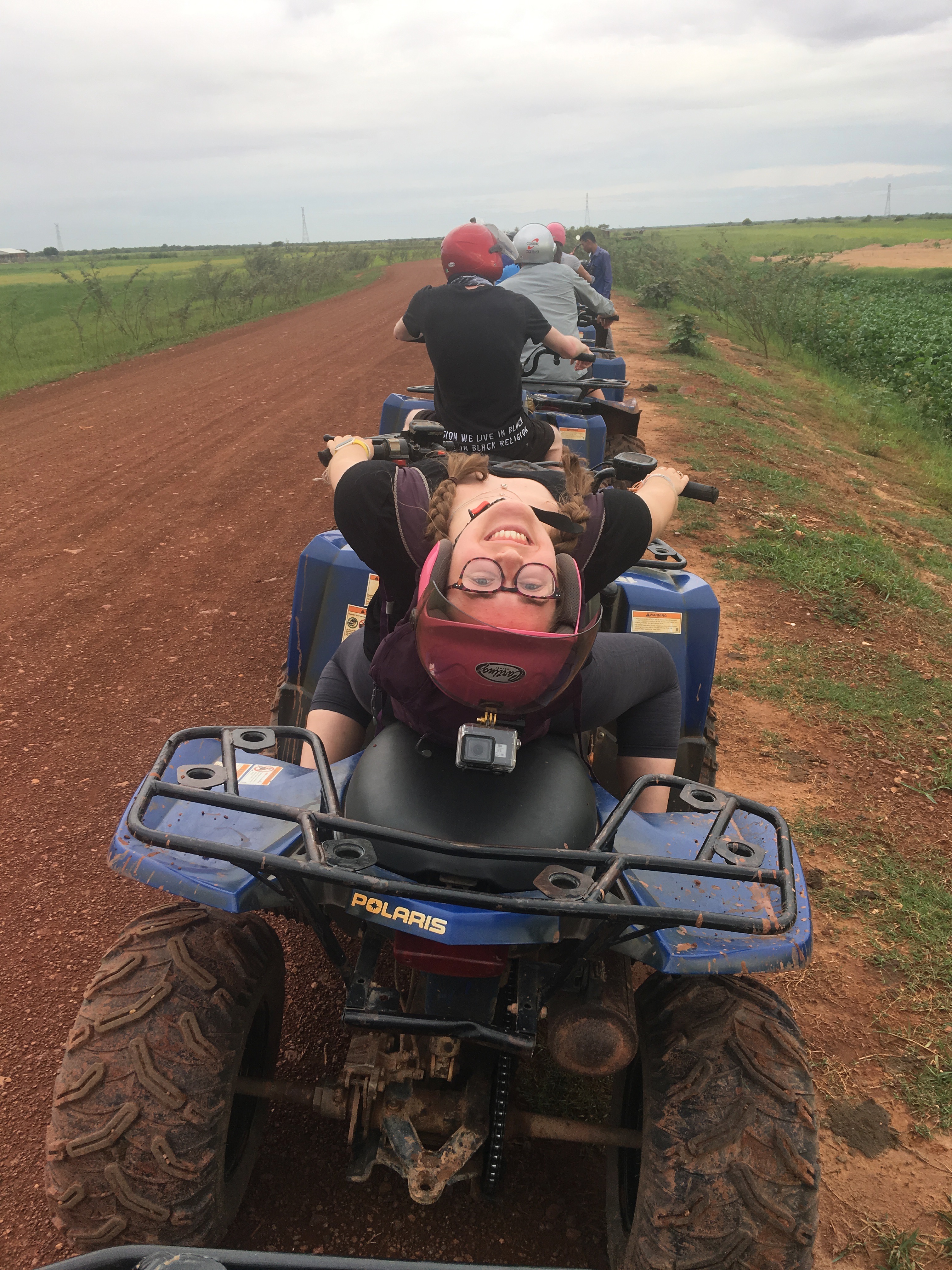 I had been briefed by my mum before boarding my flight to Bangkok: “don’t do any drugs”, “don’t go out at night” and “don’t ride any motorbikes” …. and well I’d already broken two of those rules in Vietnam alone plus she never mentioned anything about quad-biking so I was more than happy to sign my life away and don a very loose helmet! I’m not much of an adrenaline junkie but there was something so fun about hurtling along the bumpy roads at break neck speed – although the speed wasn’t a choice, I couldn’t actually reach the accelerator to release it any further. Most people (smart or boring, you decide) dodged the deep muddy puddles that filled in all the pot holes but I on the other hand just ploughed right through them and told myself that the mud was probably good for my skin.
I had been briefed by my mum before boarding my flight to Bangkok: “don’t do any drugs”, “don’t go out at night” and “don’t ride any motorbikes” …. and well I’d already broken two of those rules in Vietnam alone plus she never mentioned anything about quad-biking so I was more than happy to sign my life away and don a very loose helmet! I’m not much of an adrenaline junkie but there was something so fun about hurtling along the bumpy roads at break neck speed – although the speed wasn’t a choice, I couldn’t actually reach the accelerator to release it any further. Most people (smart or boring, you decide) dodged the deep muddy puddles that filled in all the pot holes but I on the other hand just ploughed right through them and told myself that the mud was probably good for my skin.
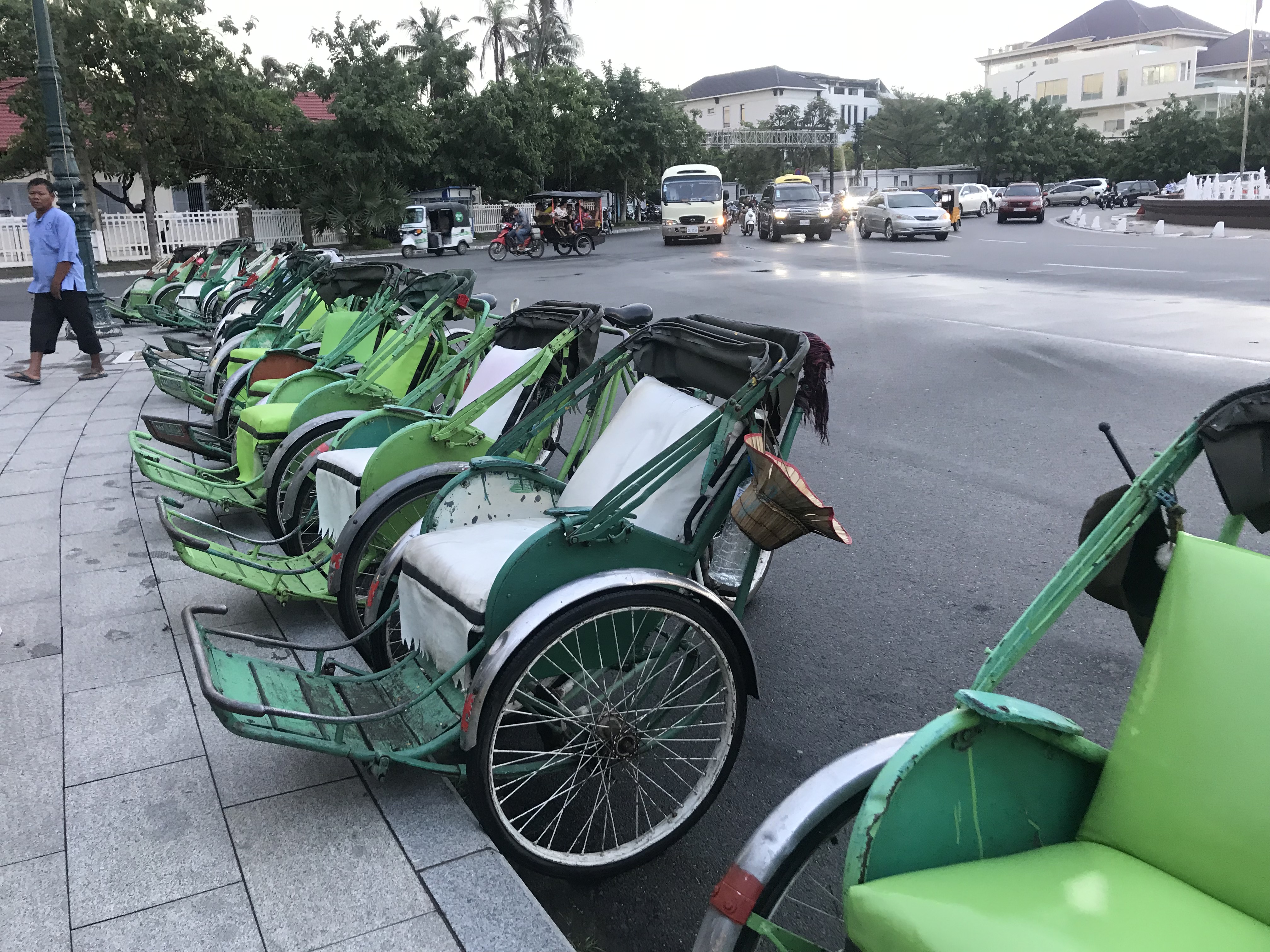 Unsurprisingly for August in South East Asia it was raining when I arrived but that didn’t stop us from taking a sunset cyclo tour around the city to orientate ourselves. Cyclos being these strange bike/tuktuk hybrids, comparable to those little tented bike attachments you put little kids in except in the adult version you sit in the front and the cyclist sits behind you and pedals. The man pedalling my cyclo thing either didn’t know how to adjust his bike or just simply enjoyed pain as he couldn’t reach either of the
Unsurprisingly for August in South East Asia it was raining when I arrived but that didn’t stop us from taking a sunset cyclo tour around the city to orientate ourselves. Cyclos being these strange bike/tuktuk hybrids, comparable to those little tented bike attachments you put little kids in except in the adult version you sit in the front and the cyclist sits behind you and pedals. The man pedalling my cyclo thing either didn’t know how to adjust his bike or just simply enjoyed pain as he couldn’t reach either of the 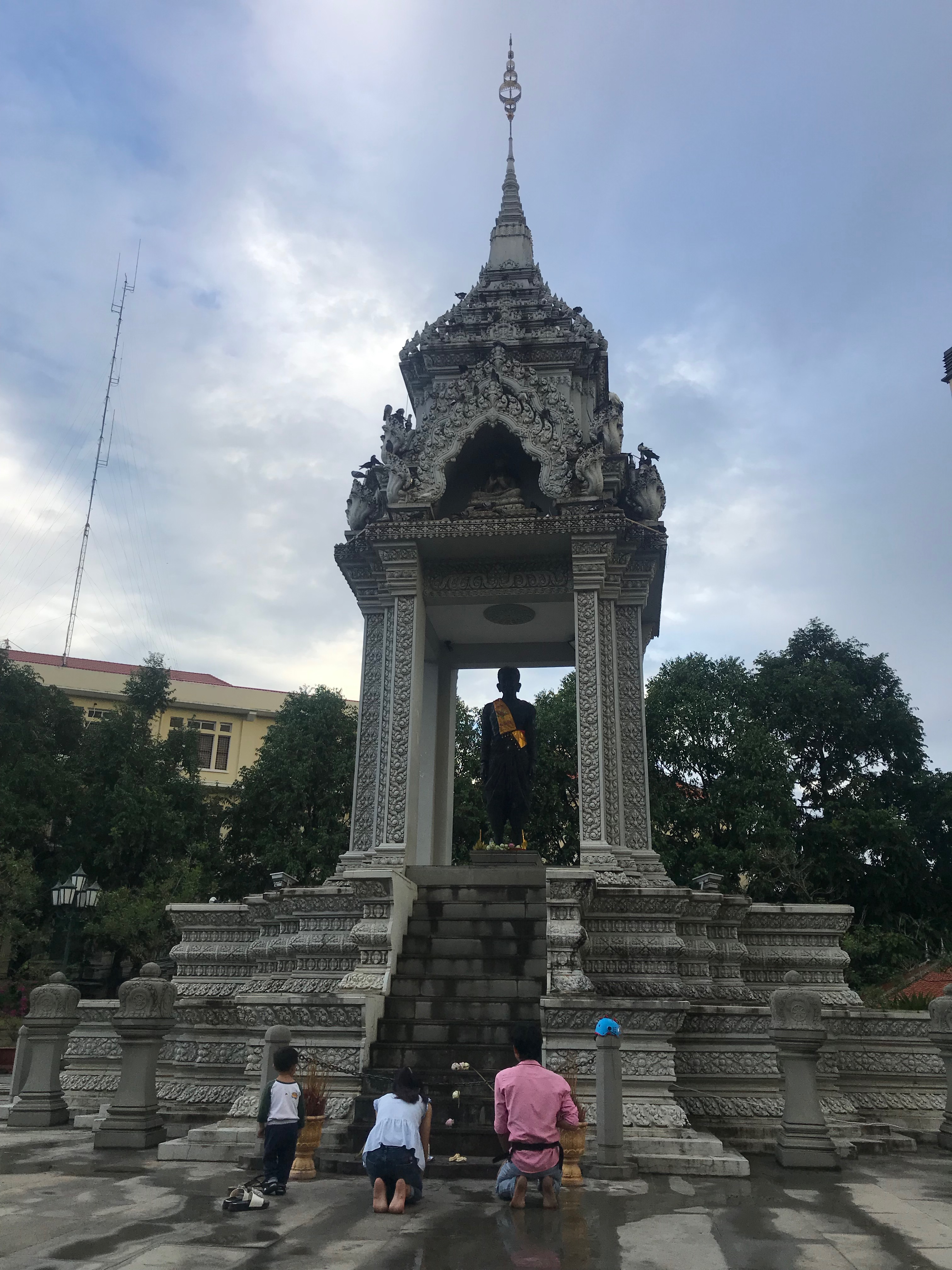 pedals! The cycloes took us to several monuments around the city that tourists usually enjoy (despite there being absolutely nobody around). First stop was the Yeay Penh monument, also known as “Our lady the founder of the city”, legend has it that Yeay Penh was a villager from the outskirts of (what is now) Phnom Penh, one day a tree washed up in her village containing solid gold Buddhas which she took to be a sign that the city needed a temple and thus she founded Wat Phnom – the main temple in Phnom Penh…..which is where we headed next. Our final stops on the cyclos took us to the independence monument which represents the independence from France in the 50’s however I was more entranced by a picture of the Cambodian queen (don’t quote me on that being her official title!) that looked spookily similar to a young Queen Liz!
pedals! The cycloes took us to several monuments around the city that tourists usually enjoy (despite there being absolutely nobody around). First stop was the Yeay Penh monument, also known as “Our lady the founder of the city”, legend has it that Yeay Penh was a villager from the outskirts of (what is now) Phnom Penh, one day a tree washed up in her village containing solid gold Buddhas which she took to be a sign that the city needed a temple and thus she founded Wat Phnom – the main temple in Phnom Penh…..which is where we headed next. Our final stops on the cyclos took us to the independence monument which represents the independence from France in the 50’s however I was more entranced by a picture of the Cambodian queen (don’t quote me on that being her official title!) that looked spookily similar to a young Queen Liz!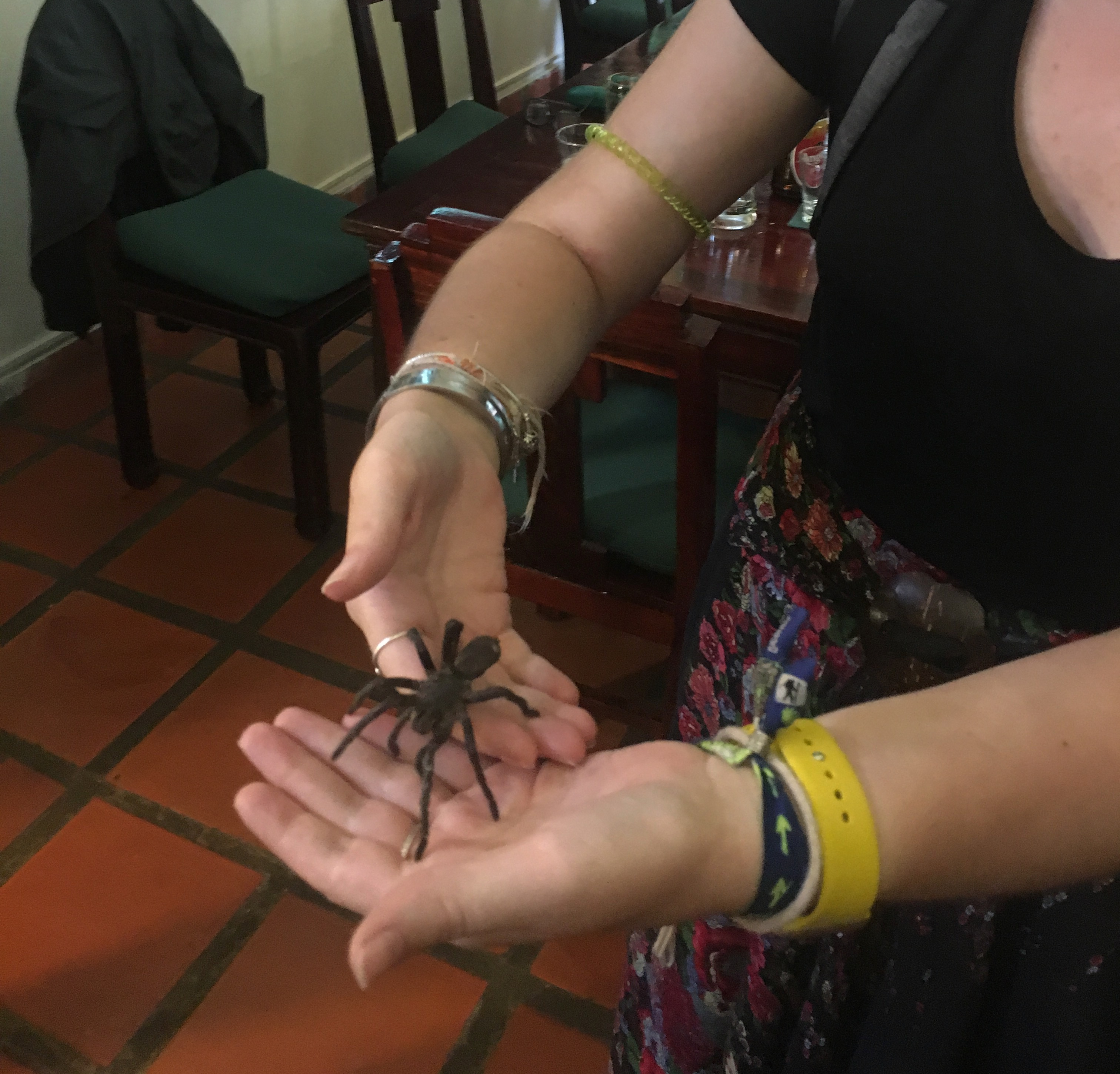 order to prevent starvation.
order to prevent starvation. 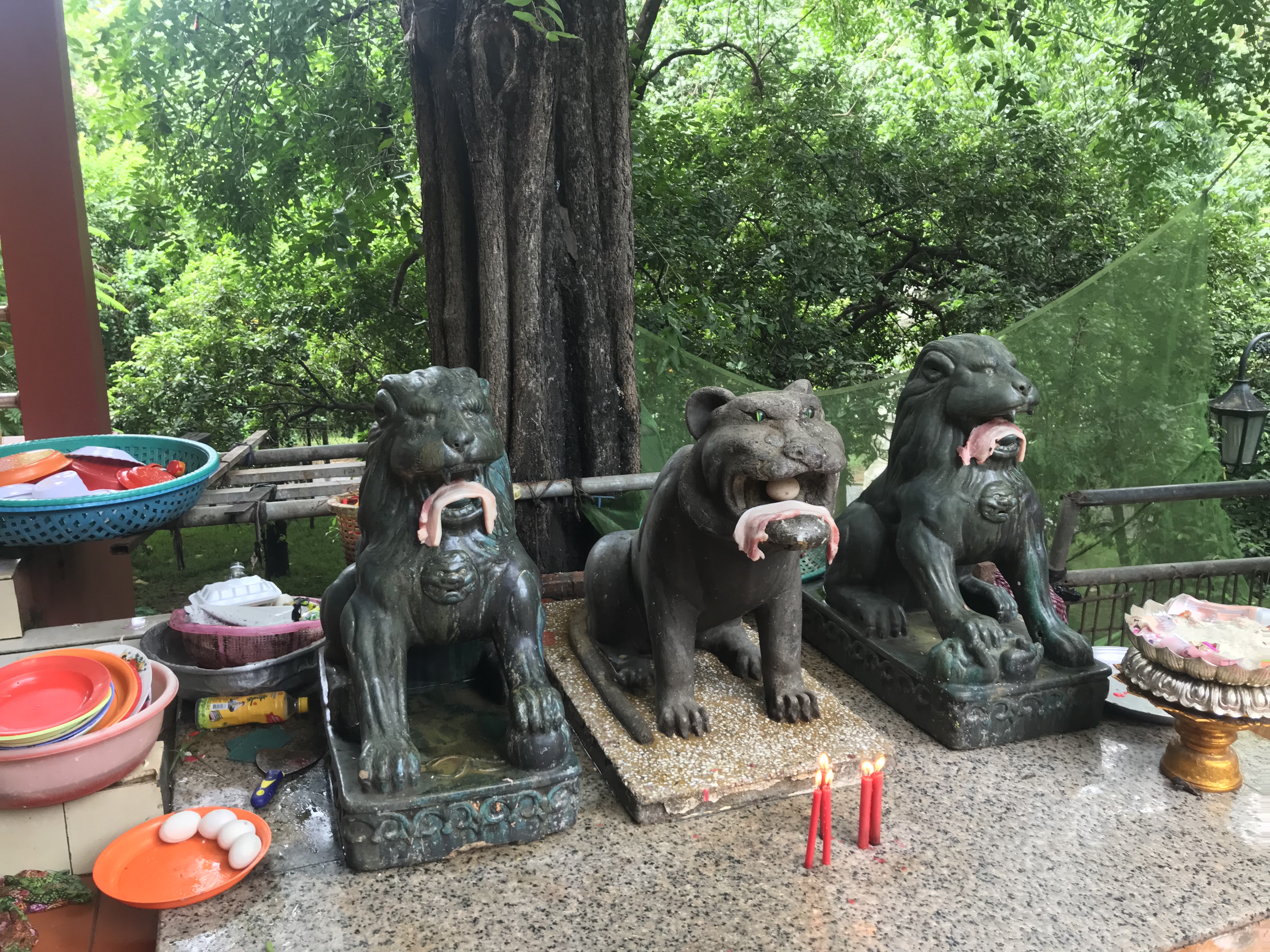 After lunch we headed up the hill to the aforementioned Wat Phnom, a beautiful almost bell-shaped gloriously white stupa atop a hill overlooking the city centre and of course, our lady founder of the city. Throughout the whole trip through South East Asia I had seen religious offerings in different forms, sometimes little shrines with candles and flowers (Pak Beng), sometimes miniature statues (Vientiane) and sometimes boxes of Americanised snacks (Hanoi) but Phnom Penh was the first time I had ever seen raw bacon offered to the statues outside of the temple.
After lunch we headed up the hill to the aforementioned Wat Phnom, a beautiful almost bell-shaped gloriously white stupa atop a hill overlooking the city centre and of course, our lady founder of the city. Throughout the whole trip through South East Asia I had seen religious offerings in different forms, sometimes little shrines with candles and flowers (Pak Beng), sometimes miniature statues (Vientiane) and sometimes boxes of Americanised snacks (Hanoi) but Phnom Penh was the first time I had ever seen raw bacon offered to the statues outside of the temple.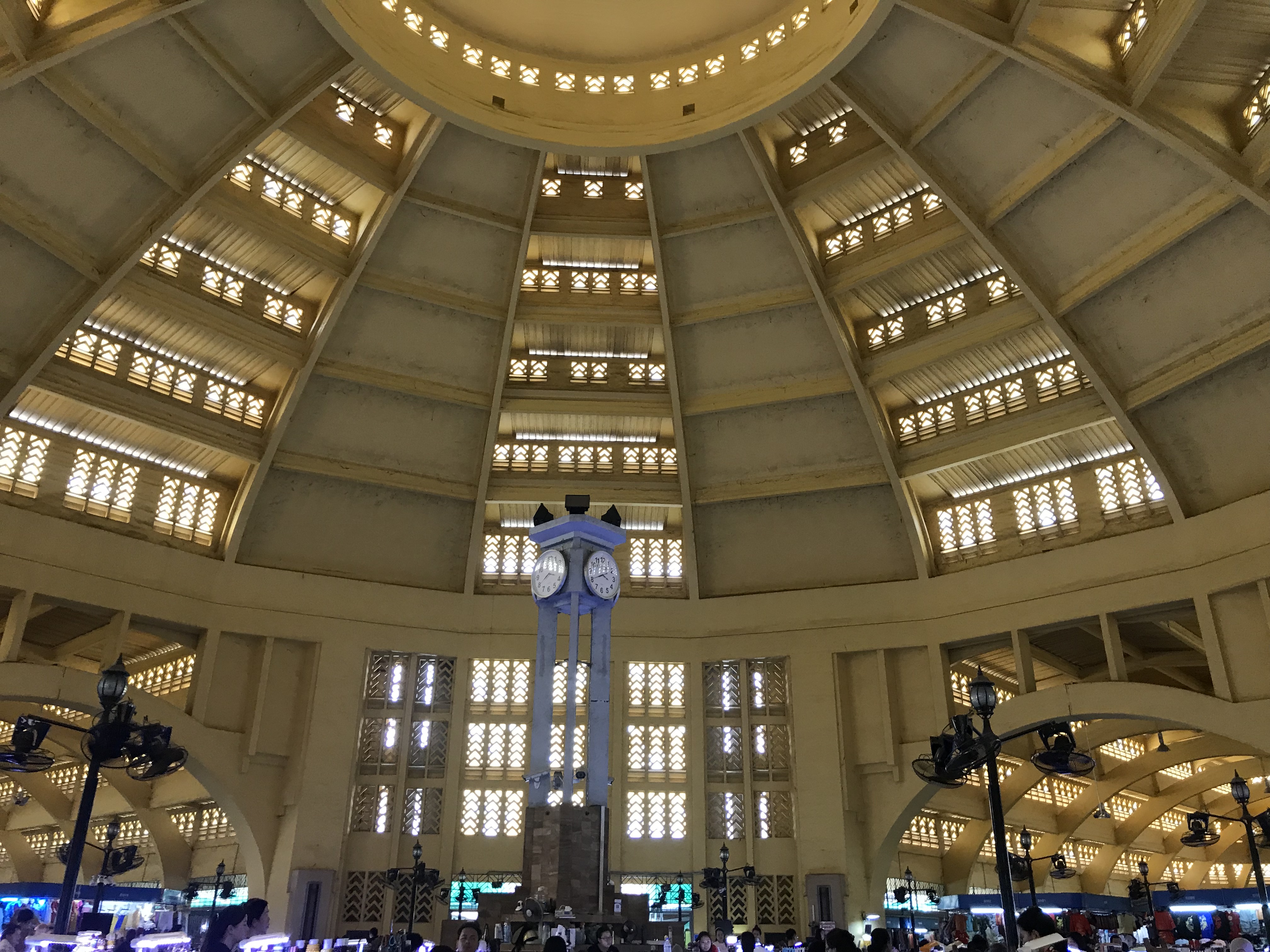 The evening was planned to be a relaxing and calm sail down the river however first, as in every city I think I’ve ever been to, you just have to pay a visit to the main market. In Phnom Penh the central market is this incredibly glamorous and flamboyant structure that seems as though it’s been transferred from a middle eastern country and plopped down in the middle of the city. The inside, if you looked up, looked like Central Station in New York yet if you looked straight ahead there were jewellers and tailors alongside live/half-dead fish thrashing about in the fish stalls, unidentifiable and mind blowingly bizarre tropical fruits in the grocer stalls and people everywhere! I couldn’t and still can’t decide whether I found it intriguing or overwhelming-either way it was probably my favourite market in the whole of South East Asia.
The evening was planned to be a relaxing and calm sail down the river however first, as in every city I think I’ve ever been to, you just have to pay a visit to the main market. In Phnom Penh the central market is this incredibly glamorous and flamboyant structure that seems as though it’s been transferred from a middle eastern country and plopped down in the middle of the city. The inside, if you looked up, looked like Central Station in New York yet if you looked straight ahead there were jewellers and tailors alongside live/half-dead fish thrashing about in the fish stalls, unidentifiable and mind blowingly bizarre tropical fruits in the grocer stalls and people everywhere! I couldn’t and still can’t decide whether I found it intriguing or overwhelming-either way it was probably my favourite market in the whole of South East Asia.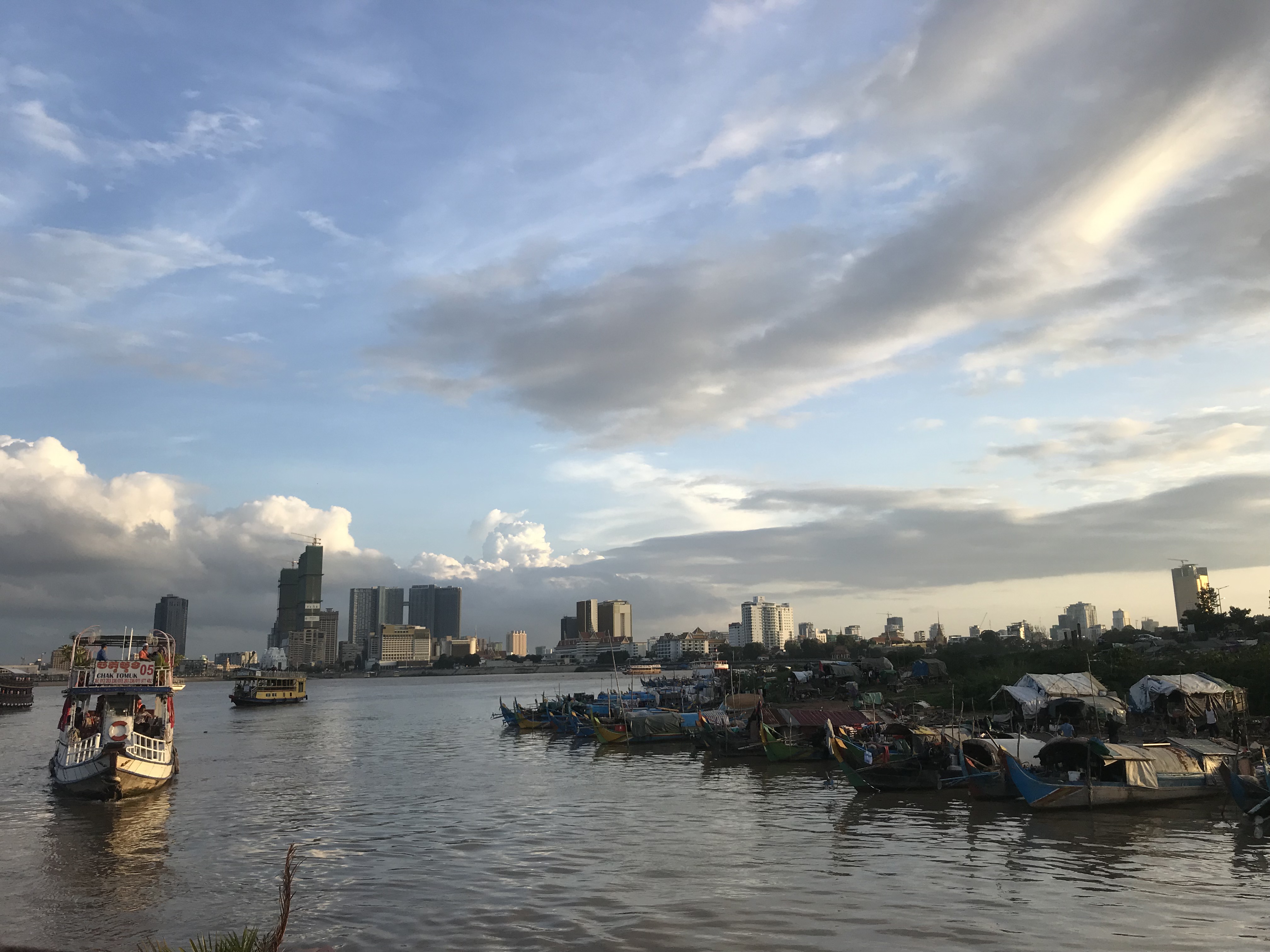 Trying to erase the image of the half-dead fish from my brain we made our way back to the promenade by the palace to get on a river boat for a sunset cruise of the Tonle Sap and Mekong rivers. Despite being a pretentious way to see the city it was undeniably the best way to see it and to see how the city was truly divided by wealth. On the one side of the Tonle Sap river you had the city centre all lit up and sparkingly in the night with it’s high-rise hotels, casinos and business districts yet on the other side, the Mekong side, just out of sight of the palace, you had a floating “village” of about a thousand local people who lived in boats with no electricity – probably not even 500m from the main promenade. So basically, from the boat, if you looked left it looked like a sparkly city and if you looked right you could see nothing but pitch black and the occasional wave reflecting the city light.
Trying to erase the image of the half-dead fish from my brain we made our way back to the promenade by the palace to get on a river boat for a sunset cruise of the Tonle Sap and Mekong rivers. Despite being a pretentious way to see the city it was undeniably the best way to see it and to see how the city was truly divided by wealth. On the one side of the Tonle Sap river you had the city centre all lit up and sparkingly in the night with it’s high-rise hotels, casinos and business districts yet on the other side, the Mekong side, just out of sight of the palace, you had a floating “village” of about a thousand local people who lived in boats with no electricity – probably not even 500m from the main promenade. So basically, from the boat, if you looked left it looked like a sparkly city and if you looked right you could see nothing but pitch black and the occasional wave reflecting the city light.
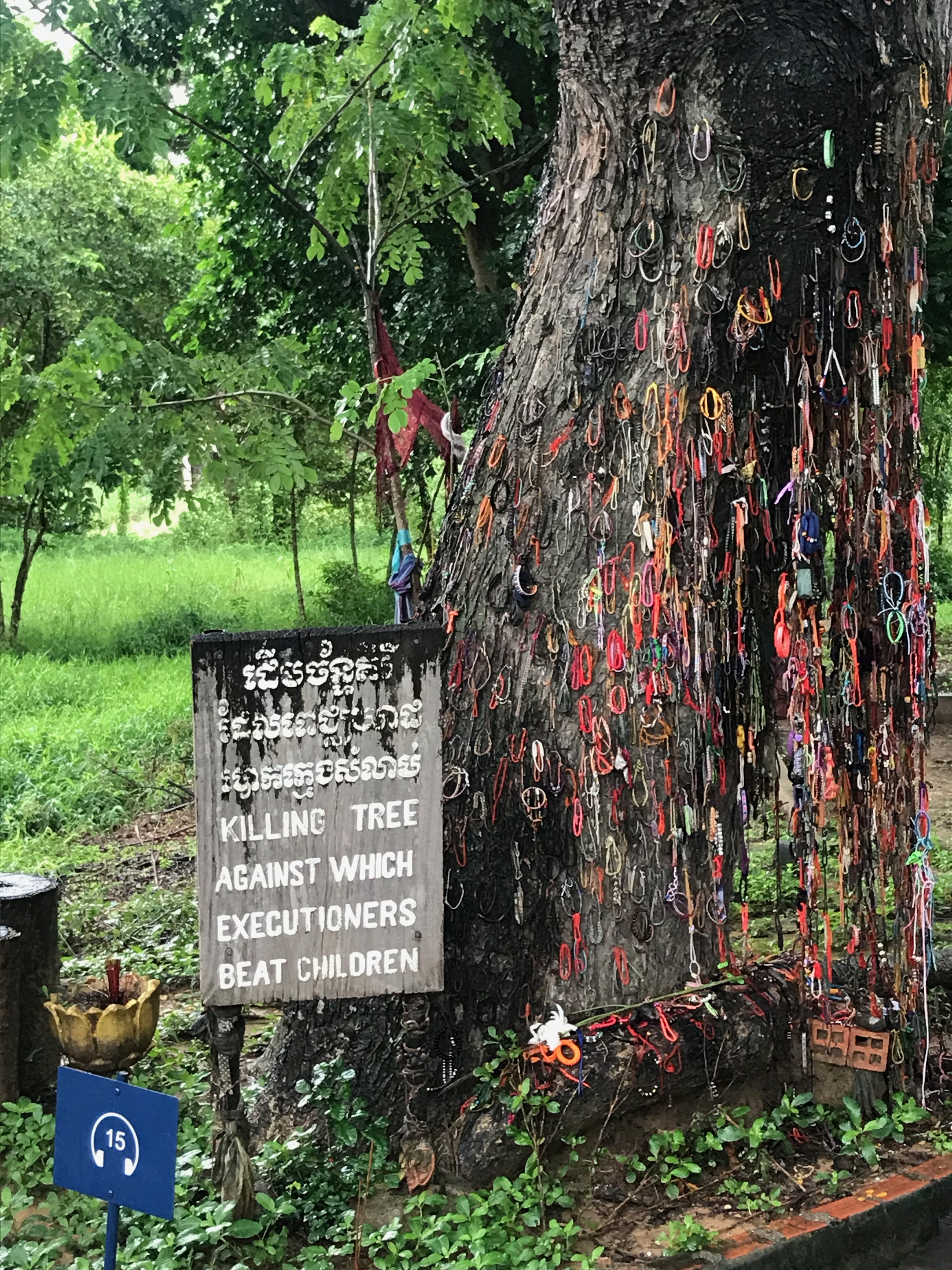 We headed early to the Choeung Ek genocidal centre which is more commonly known to westerners as the “killing fields” and just about summarises the horrors that happened there. For those, like myself, who were born decades after the genocide and weren’t given the opportunity to learn about it at school – Cambodia in the 1970’s was home to one of the worst genocides in history, one that ended with about a quarter of their entire population dead …. and it all began pretty much overnight.
We headed early to the Choeung Ek genocidal centre which is more commonly known to westerners as the “killing fields” and just about summarises the horrors that happened there. For those, like myself, who were born decades after the genocide and weren’t given the opportunity to learn about it at school – Cambodia in the 1970’s was home to one of the worst genocides in history, one that ended with about a quarter of their entire population dead …. and it all began pretty much overnight.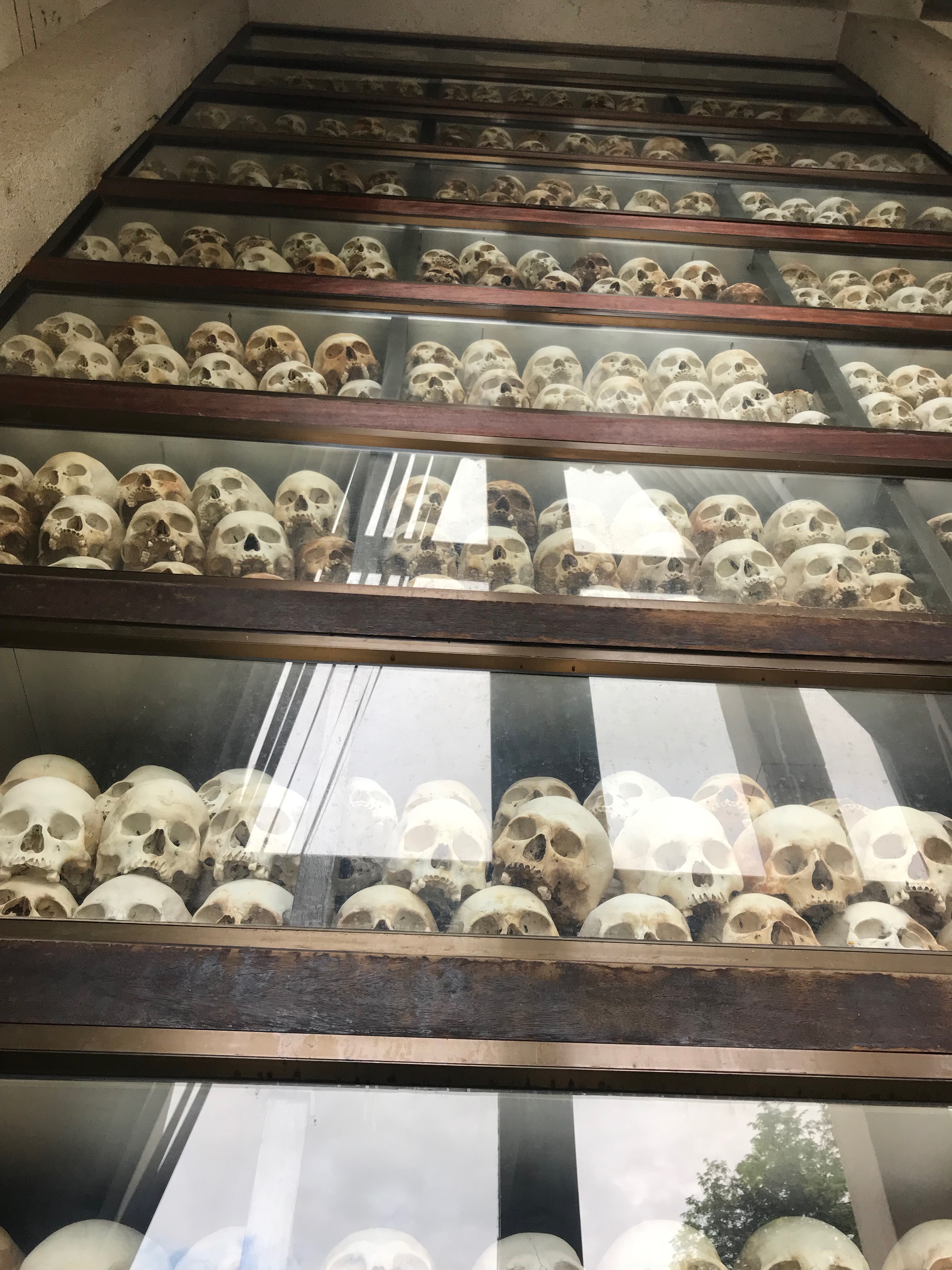
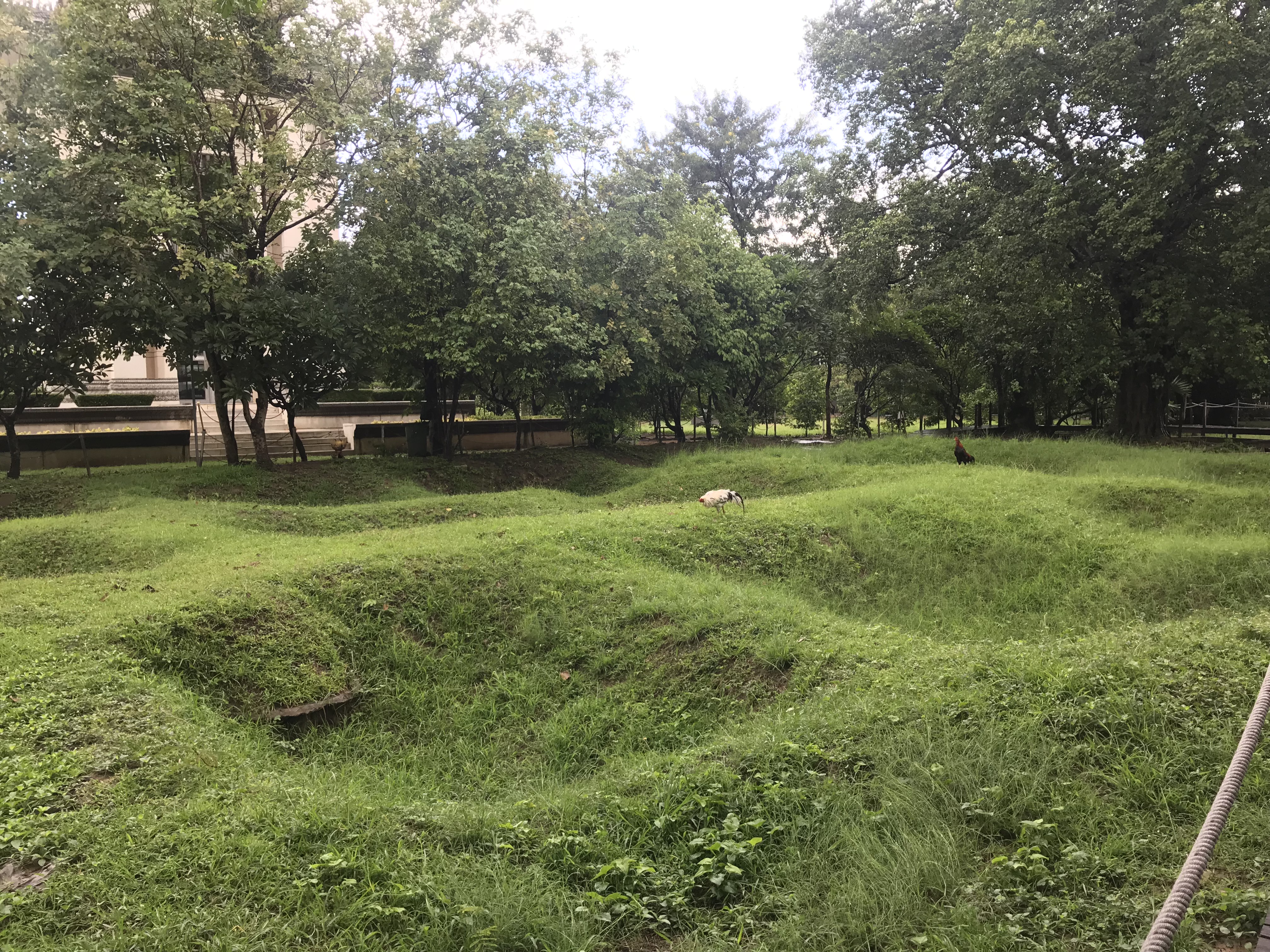 Choeung Ek was a site used primarily for murder and mass burial, even today, after the mass graves have been excavated, the site looks like the surface of the moon – everywhere you look there are muddy trenches and grassy holes in the ground dotted with prayer bracelets from visitors and occasionally a placard describing who (woman, men, girls, boys or babies) and how many people were inside … totalling around 10,000. In certain places, fragments of bone, hair and teeth were still visible however, some locals believe that the peacocks that roam freely on the site are the reincarnated spirits of the dead.
Choeung Ek was a site used primarily for murder and mass burial, even today, after the mass graves have been excavated, the site looks like the surface of the moon – everywhere you look there are muddy trenches and grassy holes in the ground dotted with prayer bracelets from visitors and occasionally a placard describing who (woman, men, girls, boys or babies) and how many people were inside … totalling around 10,000. In certain places, fragments of bone, hair and teeth were still visible however, some locals believe that the peacocks that roam freely on the site are the reincarnated spirits of the dead.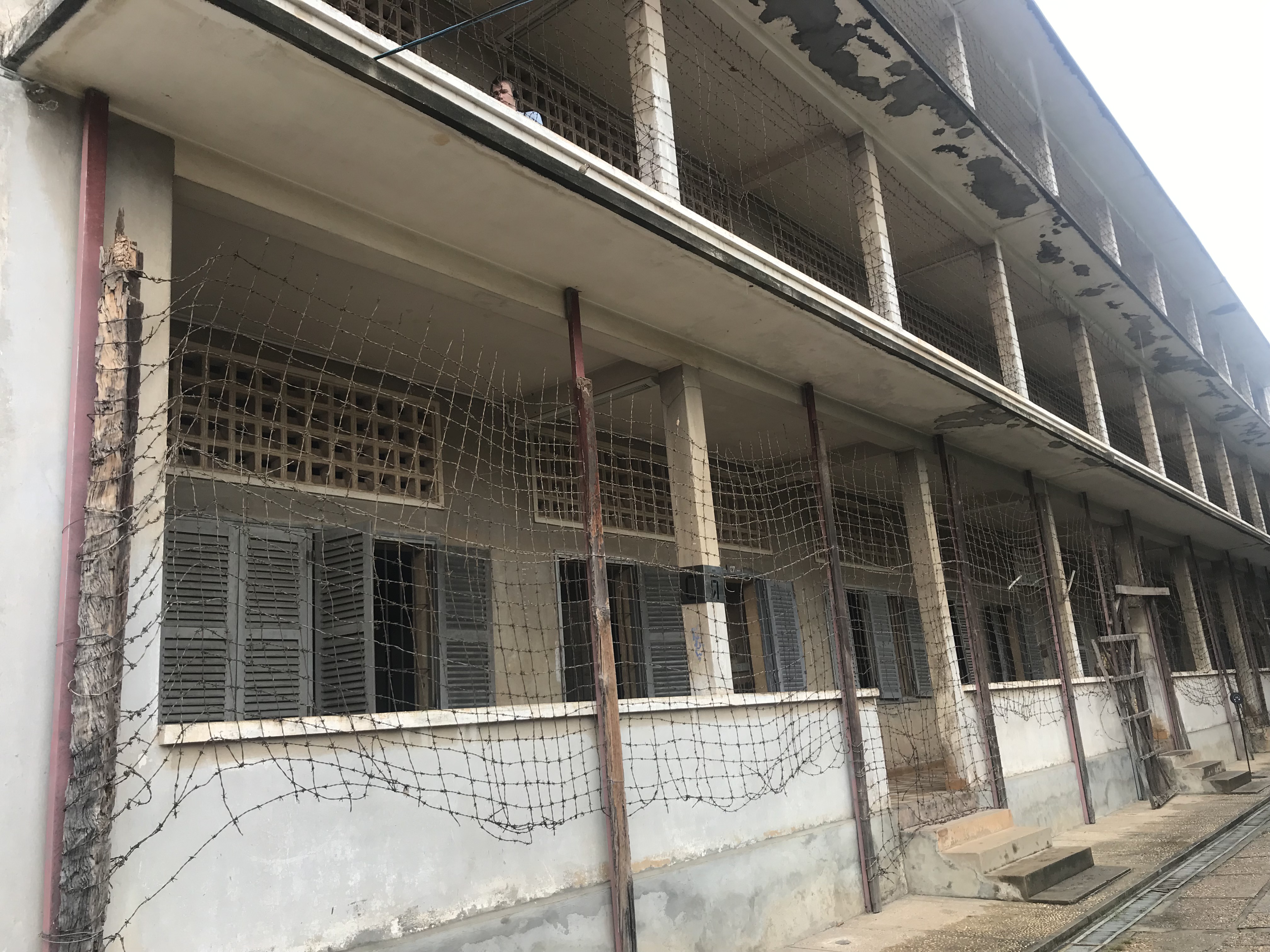 Some of the victims of Choeung Ek had previously been held in a security prison in the centre of Phnom Penh called S21 or Tuol Sleng and had been transferred to Choeung Ek either shortly before or after their assassination – somewhere that we visited later in the day to better understand the genocide and the history of the city. S21 was a former secondary school that during the regime had been converted into a prison, torture and execution centre for primarily academics, politicians and foreigners. It is said that around 15,000 people entered the prison and less than 10 survived. The museum today maintains the majority of the former school campus untouched, wire frame beds with handcuffs, cells the size of toilet cubicles, there were still blood stains on the floor, chicken wire on the balconies (to prevent inmate suicide) and French writing still on the prison hall blackboards stating the rules.
Some of the victims of Choeung Ek had previously been held in a security prison in the centre of Phnom Penh called S21 or Tuol Sleng and had been transferred to Choeung Ek either shortly before or after their assassination – somewhere that we visited later in the day to better understand the genocide and the history of the city. S21 was a former secondary school that during the regime had been converted into a prison, torture and execution centre for primarily academics, politicians and foreigners. It is said that around 15,000 people entered the prison and less than 10 survived. The museum today maintains the majority of the former school campus untouched, wire frame beds with handcuffs, cells the size of toilet cubicles, there were still blood stains on the floor, chicken wire on the balconies (to prevent inmate suicide) and French writing still on the prison hall blackboards stating the rules.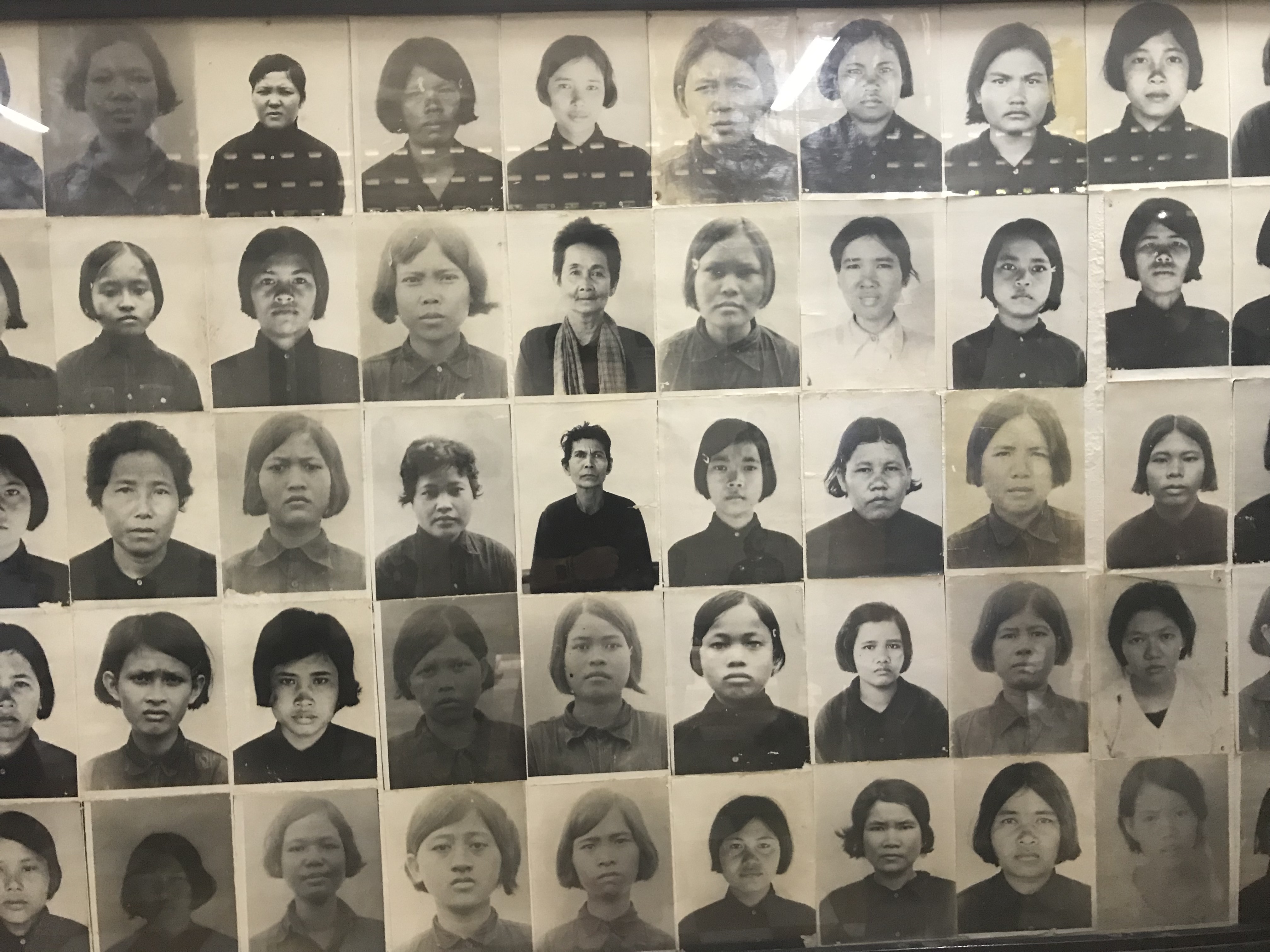 During the regime the Khmer Rouge meticulously photographed every single prisoner and transcribed interrogations, copies of which are displayed in the former classrooms. To put the almost 15,000 passport sized black and white photographs into perspective …. together they filled the surface of every wall, board, window and cabinet in at least 3 full-size classrooms. Some of the pictures displayed the horrific torture and gruesome murder of the prisoners whilst others showed the faces of people so severely emaciated they resembled children. Tuol Sleng recruited a few of the survivors of S21 to come and educate visitors and share their stories, some had written and published autobiographies but all were now the sole survivors of their families and all younger than my grandparents. As amazing as it is to have survivors of the genocide there, it was both heartbreaking and inspiring to think of the courage, strength and resilience it must have taken to return to the site that caused them so much trauma, pain and loss.
During the regime the Khmer Rouge meticulously photographed every single prisoner and transcribed interrogations, copies of which are displayed in the former classrooms. To put the almost 15,000 passport sized black and white photographs into perspective …. together they filled the surface of every wall, board, window and cabinet in at least 3 full-size classrooms. Some of the pictures displayed the horrific torture and gruesome murder of the prisoners whilst others showed the faces of people so severely emaciated they resembled children. Tuol Sleng recruited a few of the survivors of S21 to come and educate visitors and share their stories, some had written and published autobiographies but all were now the sole survivors of their families and all younger than my grandparents. As amazing as it is to have survivors of the genocide there, it was both heartbreaking and inspiring to think of the courage, strength and resilience it must have taken to return to the site that caused them so much trauma, pain and loss.
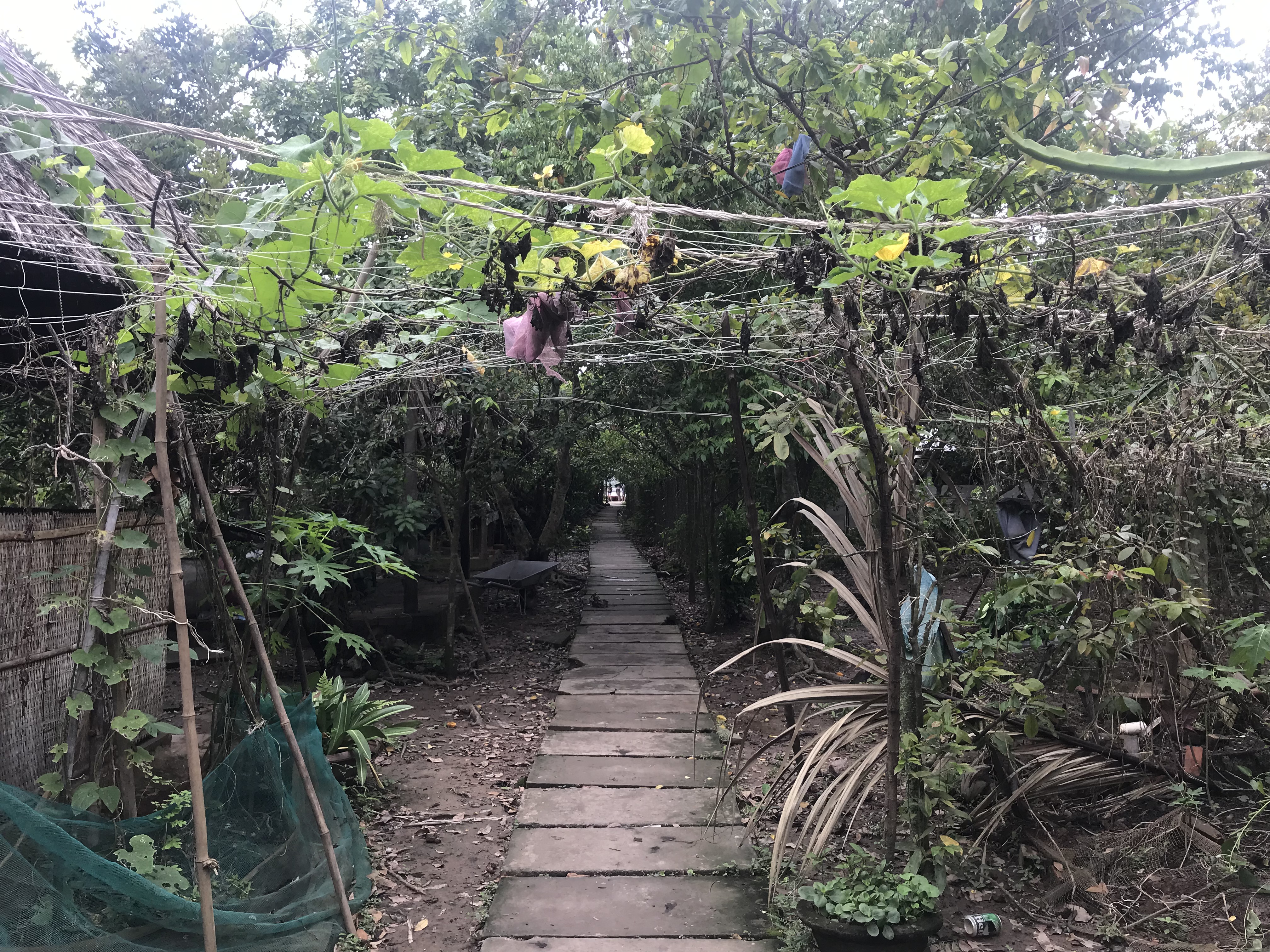 Well the first thing I did was take a two hour bus ride South out of Ho Chi Minh city to My Tho, a town on the Mekong Delta. I then took a quick ten minute boat ride (complete with a hi-vis orange life jacket) across the choppy Mekong to a little island cutely named “Unicorn Island”. You might be picturing rainbows and glitter and actual unicorns but it was mostly just lots of fruit trees, bee hives and snakes – having said that though it may as well have been actual unicorns and rainbows because I had such a good time!
Well the first thing I did was take a two hour bus ride South out of Ho Chi Minh city to My Tho, a town on the Mekong Delta. I then took a quick ten minute boat ride (complete with a hi-vis orange life jacket) across the choppy Mekong to a little island cutely named “Unicorn Island”. You might be picturing rainbows and glitter and actual unicorns but it was mostly just lots of fruit trees, bee hives and snakes – having said that though it may as well have been actual unicorns and rainbows because I had such a good time!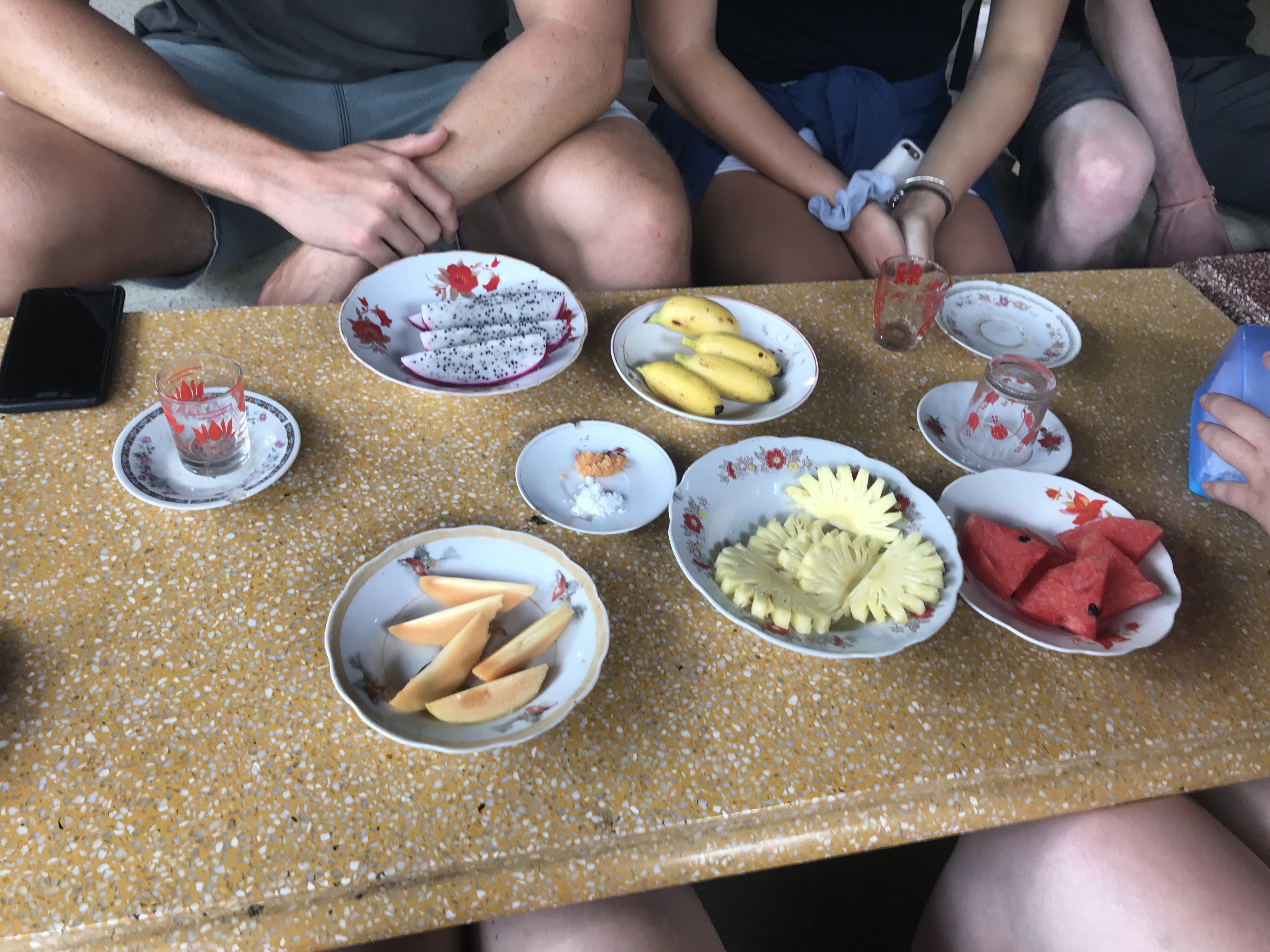 The local guide, Jo, (or Cho? I couldn’t actually hear her over the sound of the boat engine lol) took us first straight off the boat and through all the fruit trees where they were growing dragonfruit, sapodilla and lots of other kinds of unidentifiable fruits to a little table complete with traditional Vietnamese live music, fruit and herbal tea. I got to try sapodilla – which tastes kind of like caramel, both pink and white dragonfruits, watermelon, Vietnamese bananas (which are entirely different to ones in the UK, they’re short and fat and have seeds in them) and pineapple which I was encouraged to sprinkle with salt and chilli just like how the Panamanians did with green mangoes.
The local guide, Jo, (or Cho? I couldn’t actually hear her over the sound of the boat engine lol) took us first straight off the boat and through all the fruit trees where they were growing dragonfruit, sapodilla and lots of other kinds of unidentifiable fruits to a little table complete with traditional Vietnamese live music, fruit and herbal tea. I got to try sapodilla – which tastes kind of like caramel, both pink and white dragonfruits, watermelon, Vietnamese bananas (which are entirely different to ones in the UK, they’re short and fat and have seeds in them) and pineapple which I was encouraged to sprinkle with salt and chilli just like how the Panamanians did with green mangoes.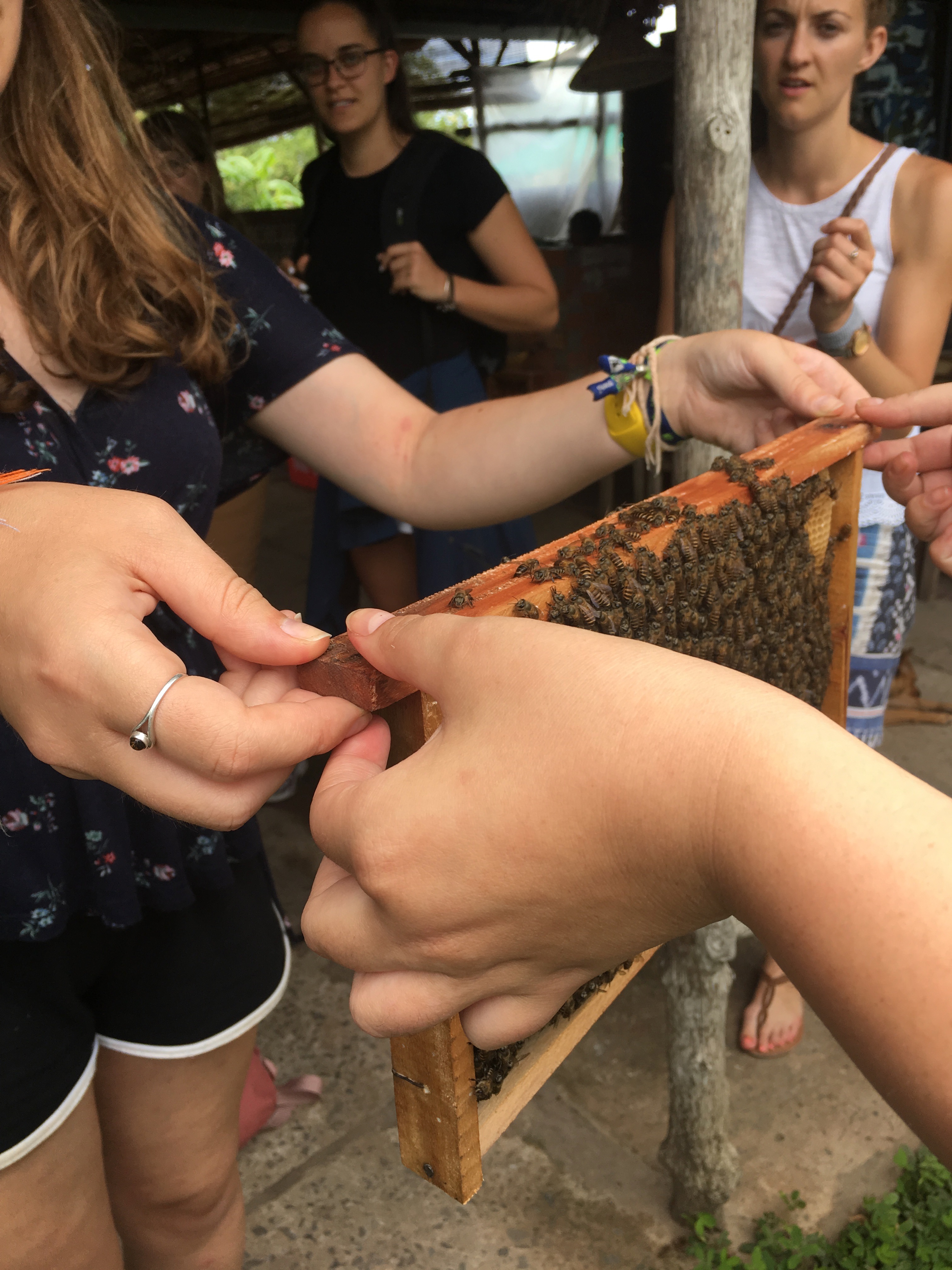 Jo/Cho then took us to a nearby bee farm that not only kept hives and harvested their own honey on site but also used every part of the honey, wax and cap to produce various products such as Royal Jelly. I’ve always been fascinated with bees and honey ever since I was a kid and found the honeycombs to be absolutely mind-blowing so I jumped at the chance to look at one up-close and hold the frame to see all the little honeybees working away without a care in the world. It was here that I got to try a local drink made of honey, lime and bee pollen. I think at home a lot of people are scared of bees and if you’ve been stung by one – fair enough, but there was something kind of reassuring about the fact that the bees happily shared the space with us, they would occasionally dive-bomb into your drink or crawl over your arm but they were only curious. Having said that though, the constant buzzing did put me on edge a bit.
Jo/Cho then took us to a nearby bee farm that not only kept hives and harvested their own honey on site but also used every part of the honey, wax and cap to produce various products such as Royal Jelly. I’ve always been fascinated with bees and honey ever since I was a kid and found the honeycombs to be absolutely mind-blowing so I jumped at the chance to look at one up-close and hold the frame to see all the little honeybees working away without a care in the world. It was here that I got to try a local drink made of honey, lime and bee pollen. I think at home a lot of people are scared of bees and if you’ve been stung by one – fair enough, but there was something kind of reassuring about the fact that the bees happily shared the space with us, they would occasionally dive-bomb into your drink or crawl over your arm but they were only curious. Having said that though, the constant buzzing did put me on edge a bit.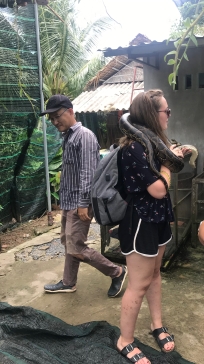 The final visit on Unicorn Island was to a cacao plantation where they sold the darkest, most bitter chocolate I’ve ever tasted. It was also where, whilst wandering around by myself in the greenhouse outside, I found a python. I managed to google translate myself a conversation with the owner/farmer and found out that it belonged to them and he, with absolutely no warning picked it up and draped it over my shoulders. It’s a bloody good job I’m not scared of snakes because that thing weighed about 5 stone and I was a little bit worried it was going to choke me as it slithered around from one shoulder to the other (bypassing my neck thank god!) but it was surprisingly very soft and felt like a big hug.
The final visit on Unicorn Island was to a cacao plantation where they sold the darkest, most bitter chocolate I’ve ever tasted. It was also where, whilst wandering around by myself in the greenhouse outside, I found a python. I managed to google translate myself a conversation with the owner/farmer and found out that it belonged to them and he, with absolutely no warning picked it up and draped it over my shoulders. It’s a bloody good job I’m not scared of snakes because that thing weighed about 5 stone and I was a little bit worried it was going to choke me as it slithered around from one shoulder to the other (bypassing my neck thank god!) but it was surprisingly very soft and felt like a big hug.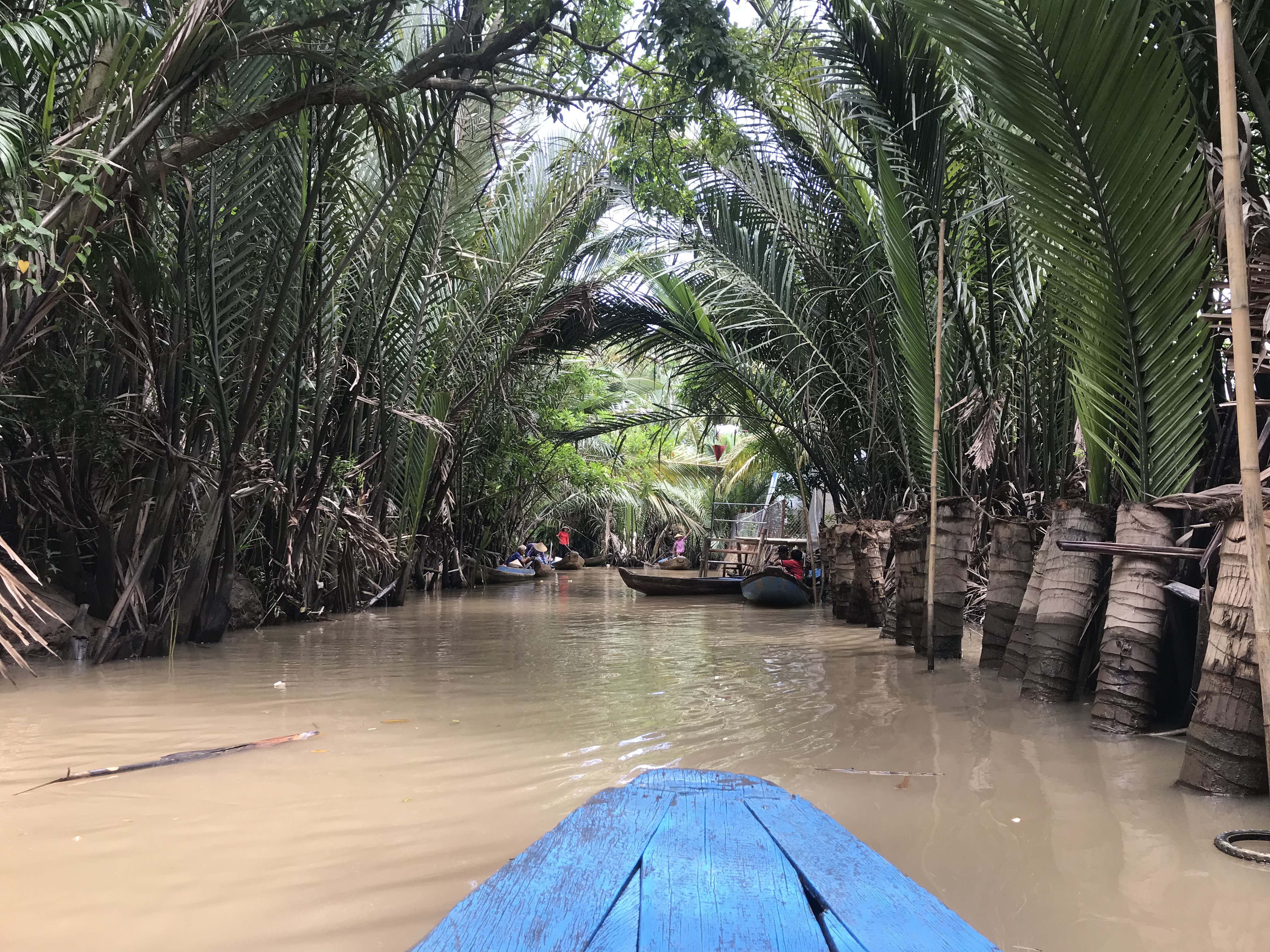 From Unicorn Island I took a boat further into the delta to an island (this time) appropriately named Coconut Island where lo and behold the main export was coconuts! We got onto little boats that were driven by long pieces of bamboo (similar to a natural version of a Venice gondola) that were pushed off the bottom of the canal/river and wove in and amongst the water coconut plantations through coconut trees taller than my house. The little boats took us to a tuktuk and on to a small coconut restaurant and shop.
From Unicorn Island I took a boat further into the delta to an island (this time) appropriately named Coconut Island where lo and behold the main export was coconuts! We got onto little boats that were driven by long pieces of bamboo (similar to a natural version of a Venice gondola) that were pushed off the bottom of the canal/river and wove in and amongst the water coconut plantations through coconut trees taller than my house. The little boats took us to a tuktuk and on to a small coconut restaurant and shop. 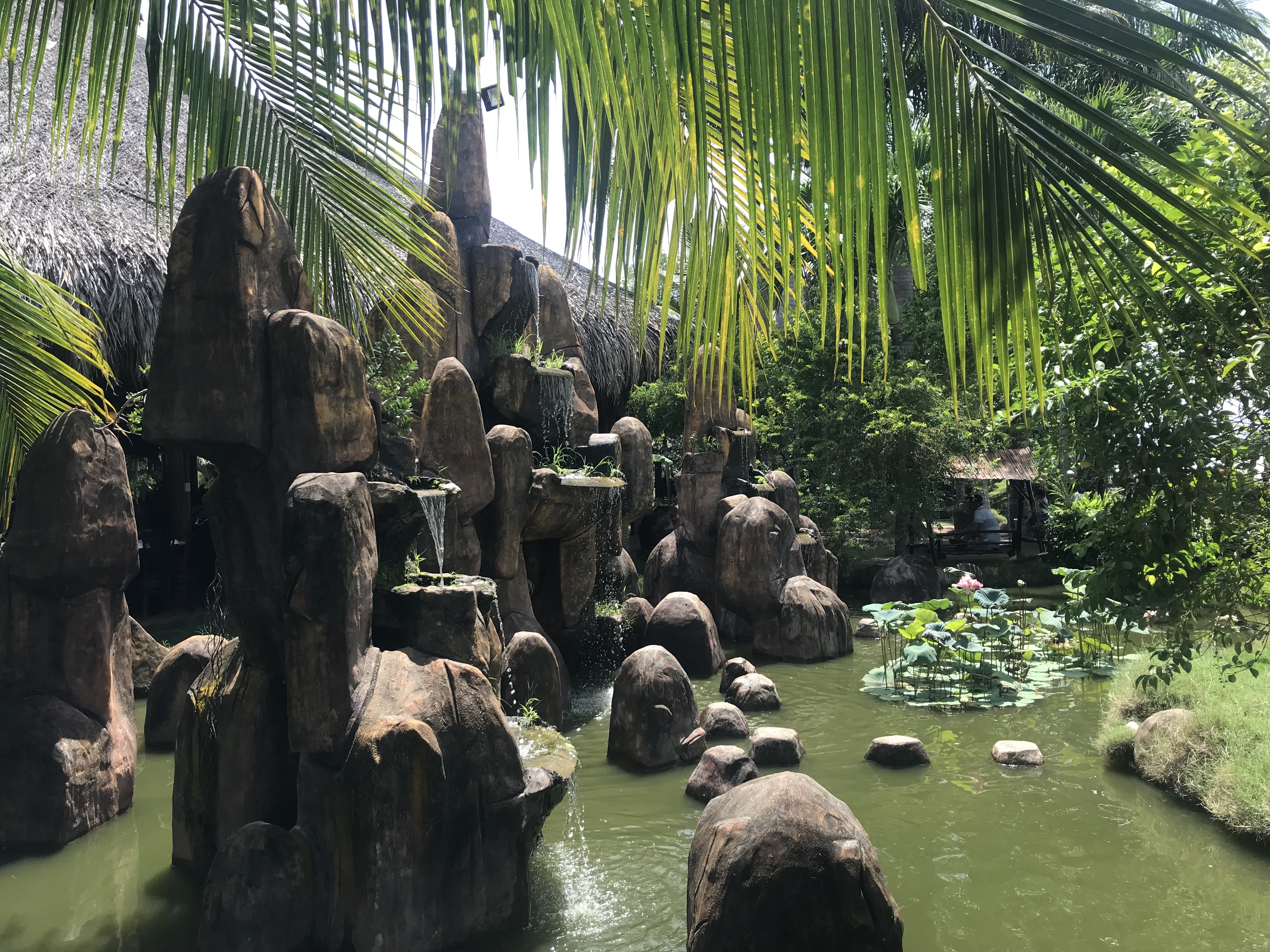 Jo/Cho took us round the back where you could see that not a single gram of the coconuts were wasted … everything was used either for kindling, fabric, oil, candy or milk. This particular restaurant specialised in selling coconut candies, they violently husked the coconuts using machetes on sticks, the husks were then set alight to heat up giant woks full of the coconut flesh and sugar, it was then quickly moulded, cooled, chopped and wrapped in waxy paper to be sold on. The restaurant also sold whisky that had dead snakes and lizards in … I’m quite glad I didn’t see how that was made!
Jo/Cho took us round the back where you could see that not a single gram of the coconuts were wasted … everything was used either for kindling, fabric, oil, candy or milk. This particular restaurant specialised in selling coconut candies, they violently husked the coconuts using machetes on sticks, the husks were then set alight to heat up giant woks full of the coconut flesh and sugar, it was then quickly moulded, cooled, chopped and wrapped in waxy paper to be sold on. The restaurant also sold whisky that had dead snakes and lizards in … I’m quite glad I didn’t see how that was made!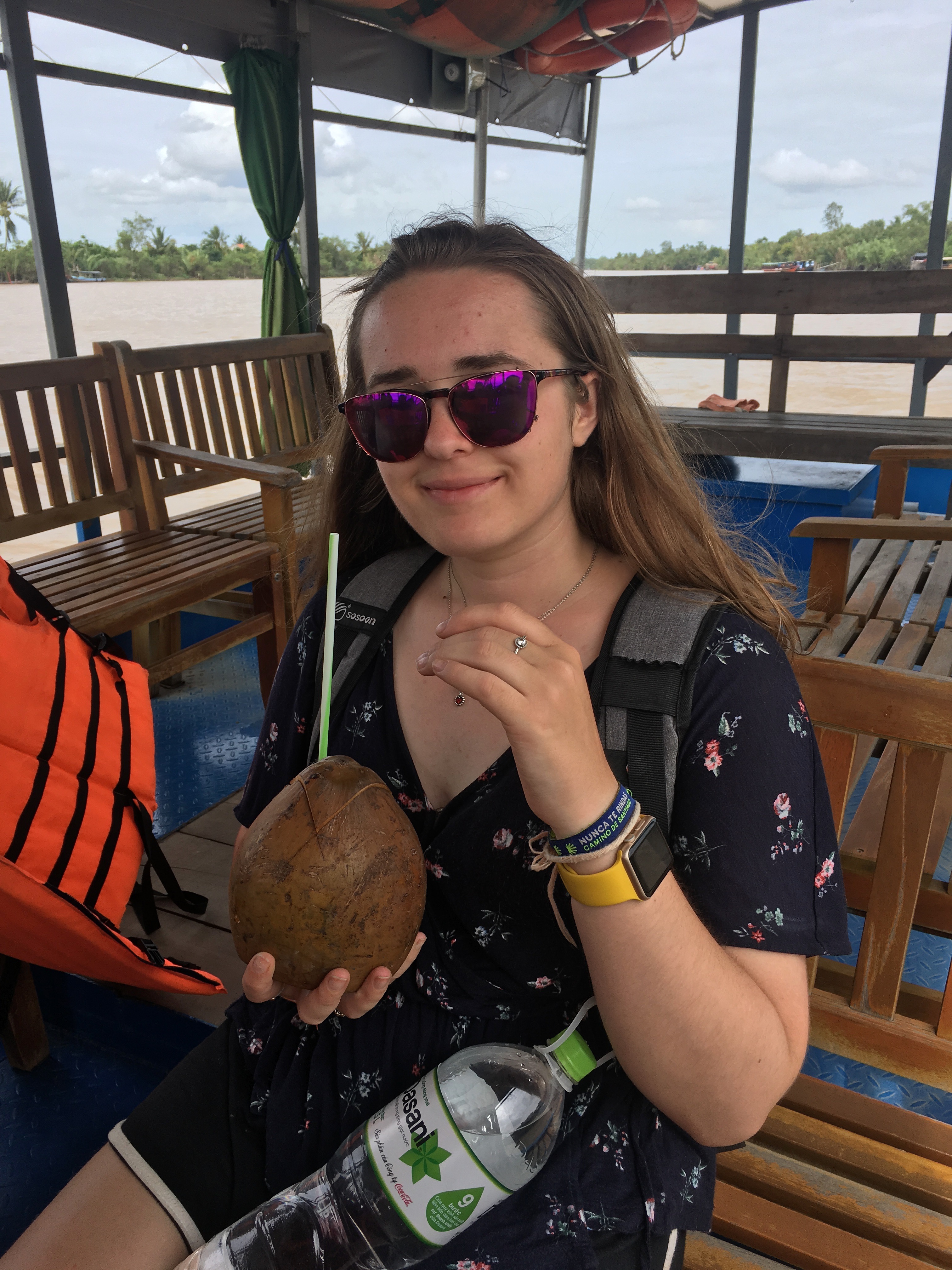 My visit to the Mekong Delta was brought to an end with a coconut full of fresh coconut water and by sailing past the fish sauce factory … which you could unfortunately smell (and almost taste!) longgg before you could see it.
My visit to the Mekong Delta was brought to an end with a coconut full of fresh coconut water and by sailing past the fish sauce factory … which you could unfortunately smell (and almost taste!) longgg before you could see it.

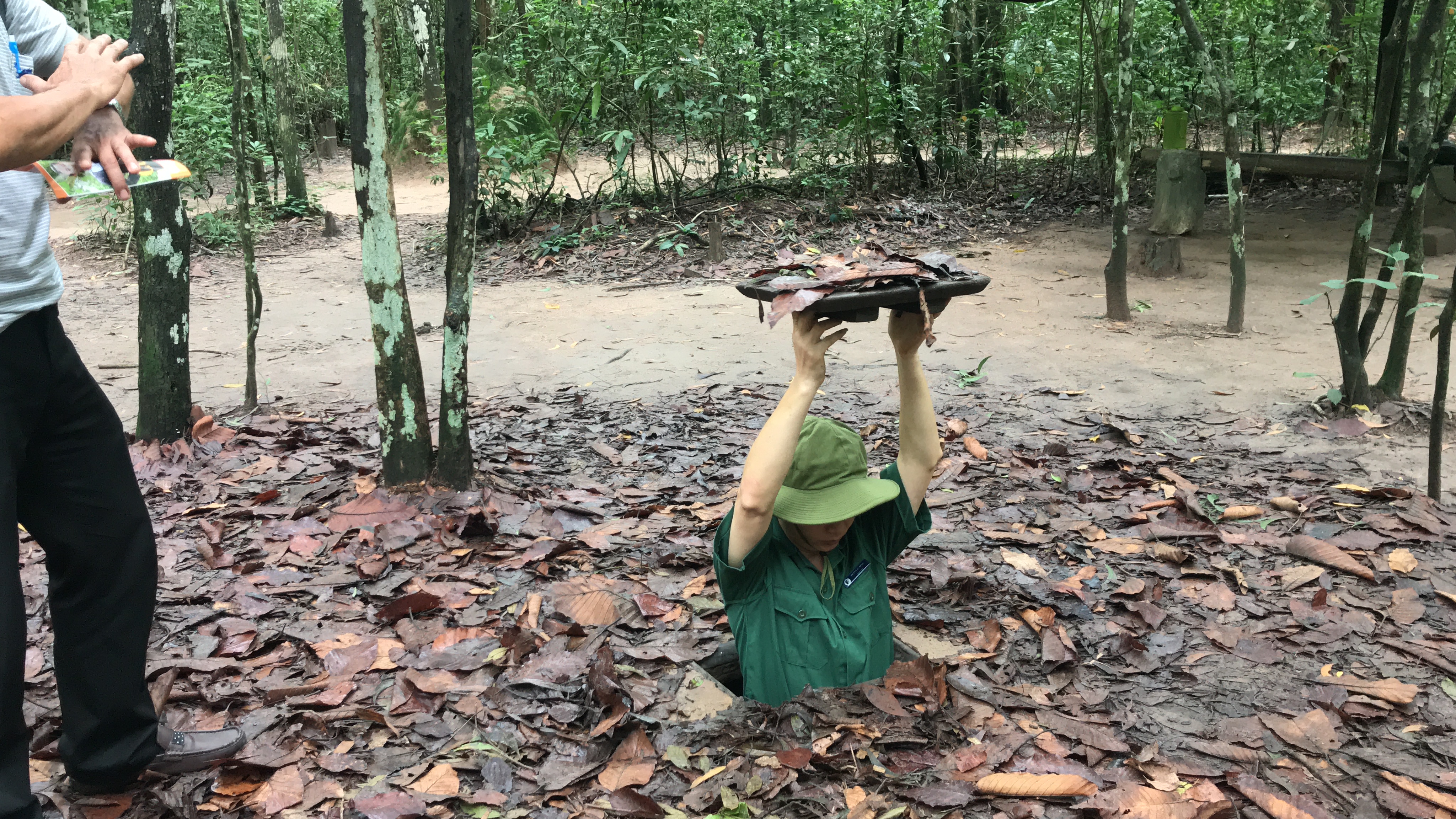 On the second day in Ho Chi Minh I took an organised trip to the Cu Chi tunnels, about an hour north of the city. There is a very long and complex history with the Cu Chi tunnels but to summarise, during the Vietnam war, the Guerilla Viet Cong troops dug thousands of miles worth of tunnels to be used for safe passage and to relay supplies and communication across an area that was heavily bombed by the Americans. In some cases, entire populations of people relocated below ground to protect themselves from the incessant bombing.
On the second day in Ho Chi Minh I took an organised trip to the Cu Chi tunnels, about an hour north of the city. There is a very long and complex history with the Cu Chi tunnels but to summarise, during the Vietnam war, the Guerilla Viet Cong troops dug thousands of miles worth of tunnels to be used for safe passage and to relay supplies and communication across an area that was heavily bombed by the Americans. In some cases, entire populations of people relocated below ground to protect themselves from the incessant bombing.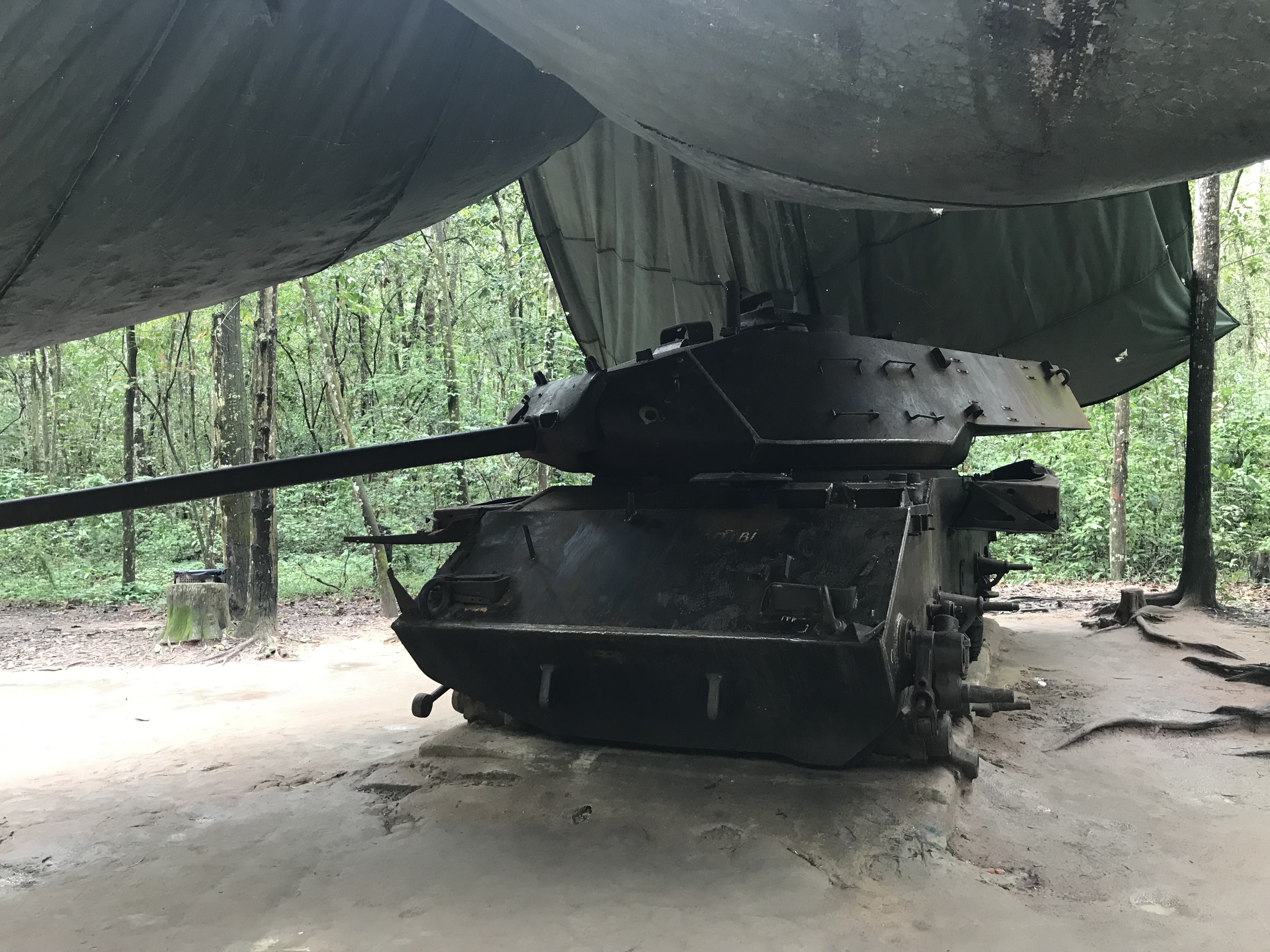 American and South Vietnamese soldiers attempted to find and catch the Viet Cong troops by sending in soldiers they called “tunnel rats” to navigate sections of the tunnels and detect booby-traps hidden by the Viet Cong. However the Viet Cong had meticulously planned the tunnels by hiding the entrances and disguising air and smoke vents as ant hills and bushes. The Americans were much more heavily armed so the Viet Cong troops booby-trapped both the tunnels and the surrounding areas with a series of more traditional yet ingenious traps, most of which involved some sort of sharpened spike upon which enemy soldiers were impaled!
American and South Vietnamese soldiers attempted to find and catch the Viet Cong troops by sending in soldiers they called “tunnel rats” to navigate sections of the tunnels and detect booby-traps hidden by the Viet Cong. However the Viet Cong had meticulously planned the tunnels by hiding the entrances and disguising air and smoke vents as ant hills and bushes. The Americans were much more heavily armed so the Viet Cong troops booby-trapped both the tunnels and the surrounding areas with a series of more traditional yet ingenious traps, most of which involved some sort of sharpened spike upon which enemy soldiers were impaled!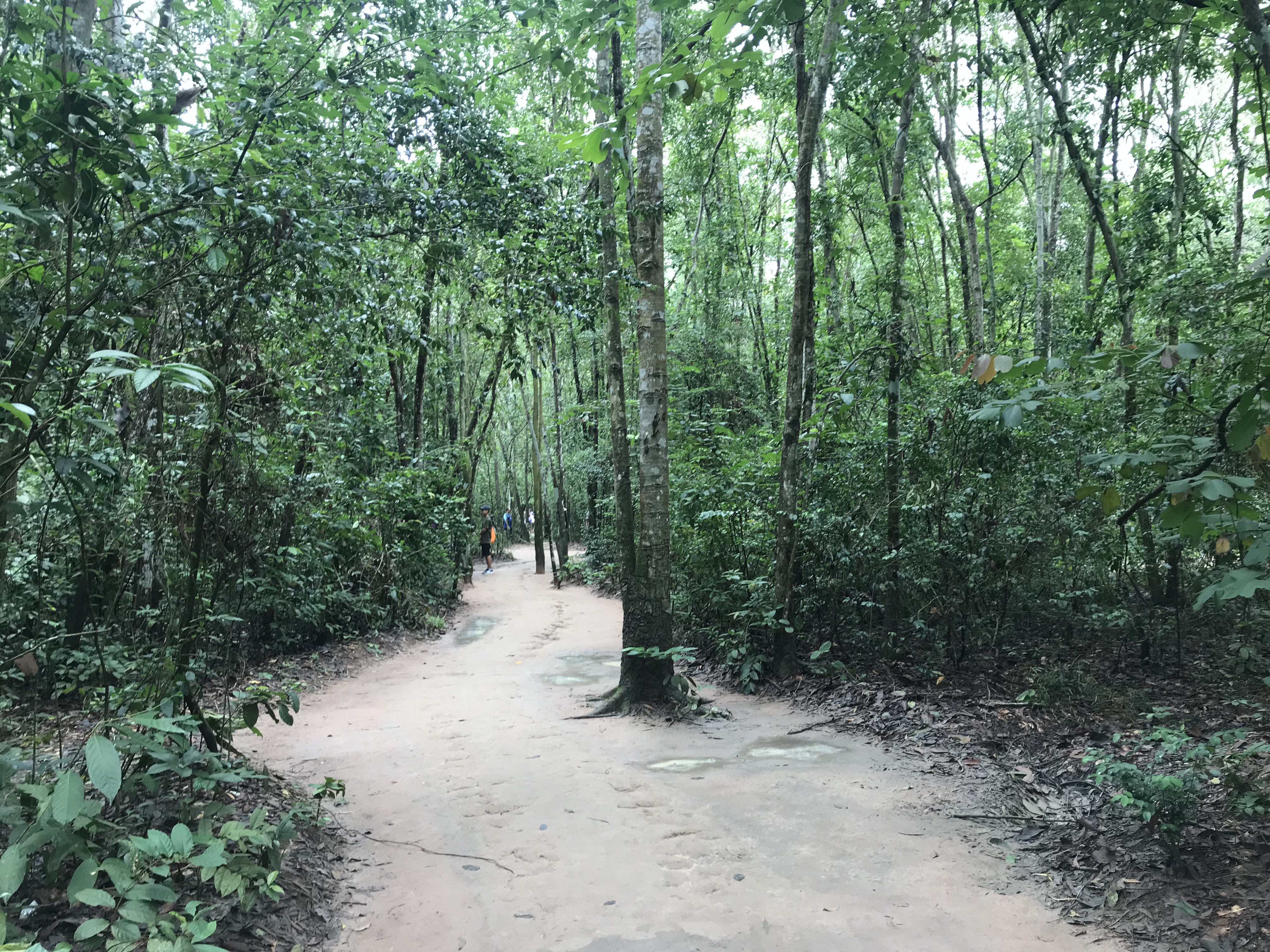 Over the course of the Vietnam war, and upon the fall of Saigon, nearly 50,000 Vietnamese men and women were said to have lost their lives defending the Cu Chi tunnels. Nowadays, the government has protected the tunnels to allow visitors from around the world to come and learn the history and experience some of the reinforced tunnels firsthand. Many of the air/smoke vents are still standing some nearly 50 years later and the booby traps have been recreated (safely!) in an open-air museum to allow visitors to better picture how the tunnels once looked to both the Viet Cong and American soldiers. However, for reasons that I do not understand, a shooting range was also built on the site to allow tourists to shoot AK-47s – this meant that (perhaps realistically?) as you walk amongst the tunnels there is the constant sound of gunfire.
Over the course of the Vietnam war, and upon the fall of Saigon, nearly 50,000 Vietnamese men and women were said to have lost their lives defending the Cu Chi tunnels. Nowadays, the government has protected the tunnels to allow visitors from around the world to come and learn the history and experience some of the reinforced tunnels firsthand. Many of the air/smoke vents are still standing some nearly 50 years later and the booby traps have been recreated (safely!) in an open-air museum to allow visitors to better picture how the tunnels once looked to both the Viet Cong and American soldiers. However, for reasons that I do not understand, a shooting range was also built on the site to allow tourists to shoot AK-47s – this meant that (perhaps realistically?) as you walk amongst the tunnels there is the constant sound of gunfire.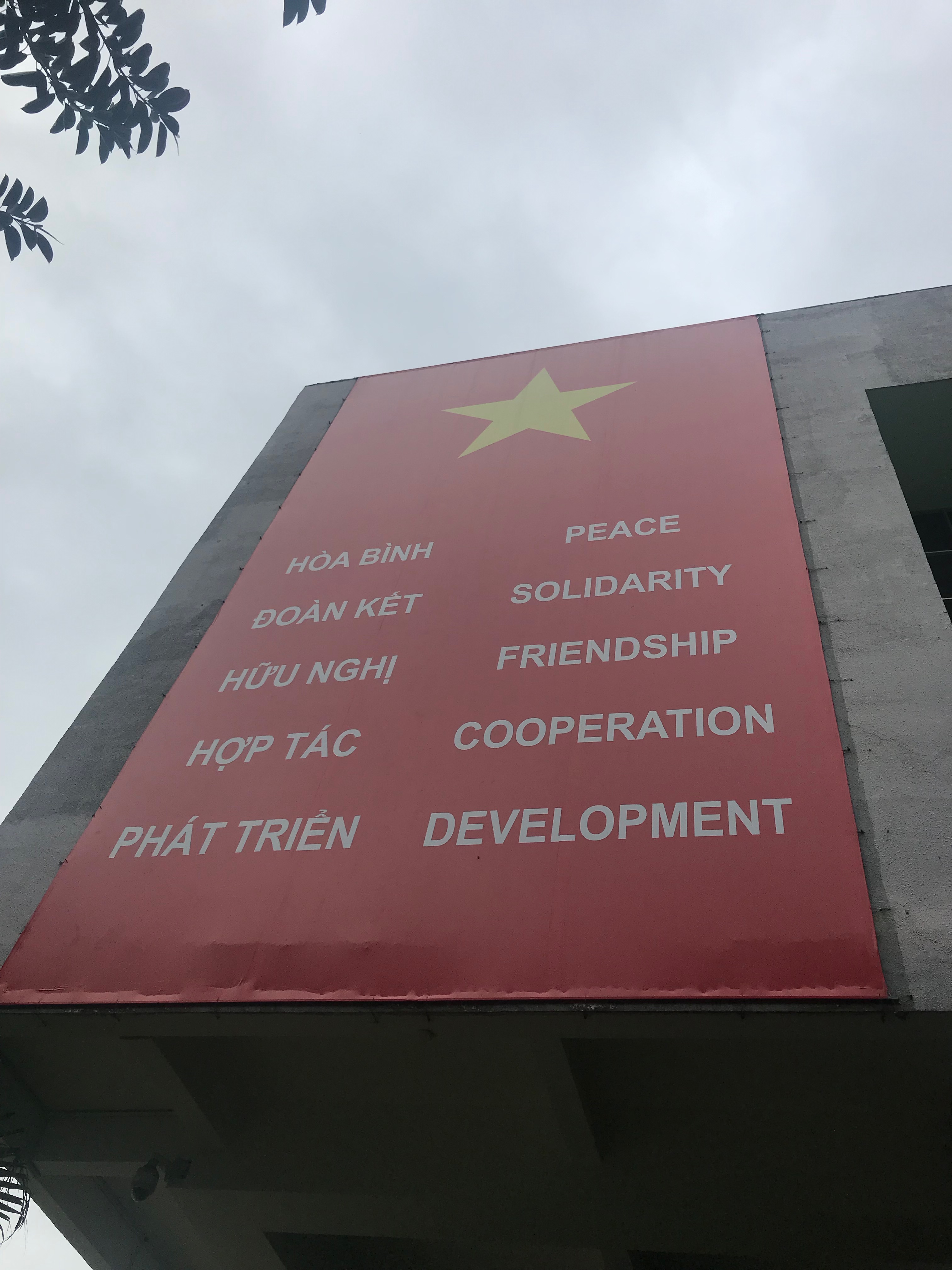 Later on during my trip to Ho Chi Minh I paid a visit to the War Remnants Museum in the city centre of Ho Chi Minh. This was where I could see photos, statements and artefacts from the war in general whereas Cu Chi told primarily the history of the tunnels. I’m a museum lover anyway but none had ever moved me to tears before this one. Not only was the museum beautifully and respectfully organised (with spaces to sit and watch documentaries and news recordings from the war) but they provided employment for people handicapped by the war or by Agent Orange who might struggle to find adapted work elsewhere in the city.
Later on during my trip to Ho Chi Minh I paid a visit to the War Remnants Museum in the city centre of Ho Chi Minh. This was where I could see photos, statements and artefacts from the war in general whereas Cu Chi told primarily the history of the tunnels. I’m a museum lover anyway but none had ever moved me to tears before this one. Not only was the museum beautifully and respectfully organised (with spaces to sit and watch documentaries and news recordings from the war) but they provided employment for people handicapped by the war or by Agent Orange who might struggle to find adapted work elsewhere in the city.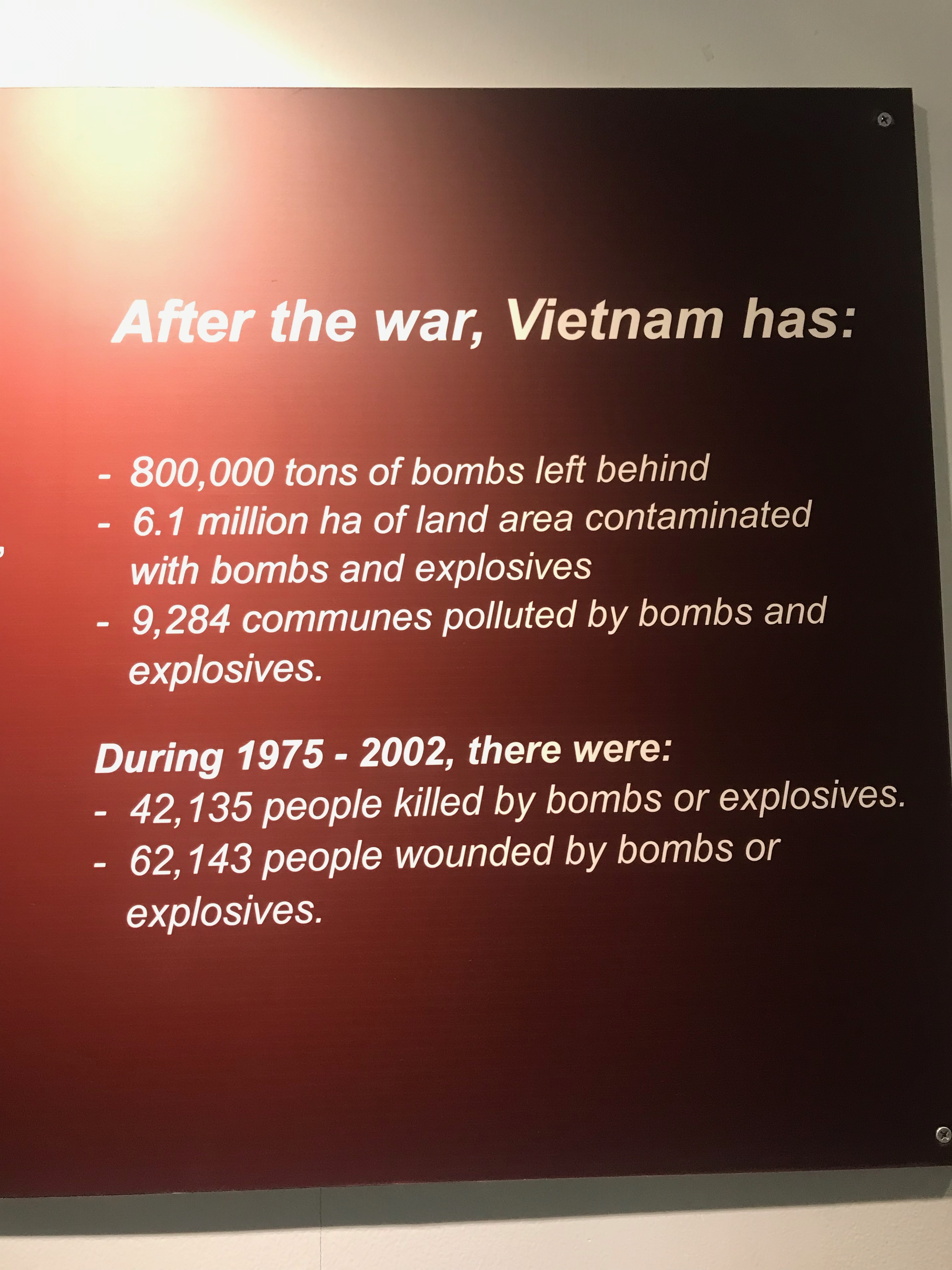 Unfortunately, these narratives by the photographers and journalists were often filled with the terror and trauma of knowing that the subjects of their photos and articles would not have survived – some were even murdered in front of them. The photos and their accompanying stories raised a lot of moral questions for me: how could anyone stand by and photograph children dying, men being murdered or whole villages being burnt to nothing? But I vividly remember, on the corner of the second floor gallery, a photo of a Vietnamese man begging for his life with a gun pointed to his head, the photographer had written beneath it “I said wait as I took the picture but as I turned around I heard a gunshot”. I wish to say that that was the most haunting picture/story in the museum but it was far from it.
Unfortunately, these narratives by the photographers and journalists were often filled with the terror and trauma of knowing that the subjects of their photos and articles would not have survived – some were even murdered in front of them. The photos and their accompanying stories raised a lot of moral questions for me: how could anyone stand by and photograph children dying, men being murdered or whole villages being burnt to nothing? But I vividly remember, on the corner of the second floor gallery, a photo of a Vietnamese man begging for his life with a gun pointed to his head, the photographer had written beneath it “I said wait as I took the picture but as I turned around I heard a gunshot”. I wish to say that that was the most haunting picture/story in the museum but it was far from it.